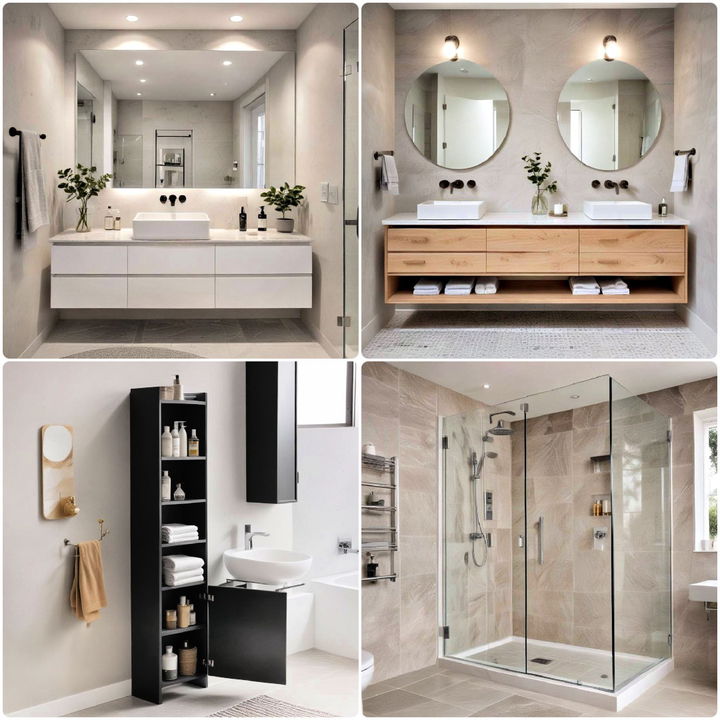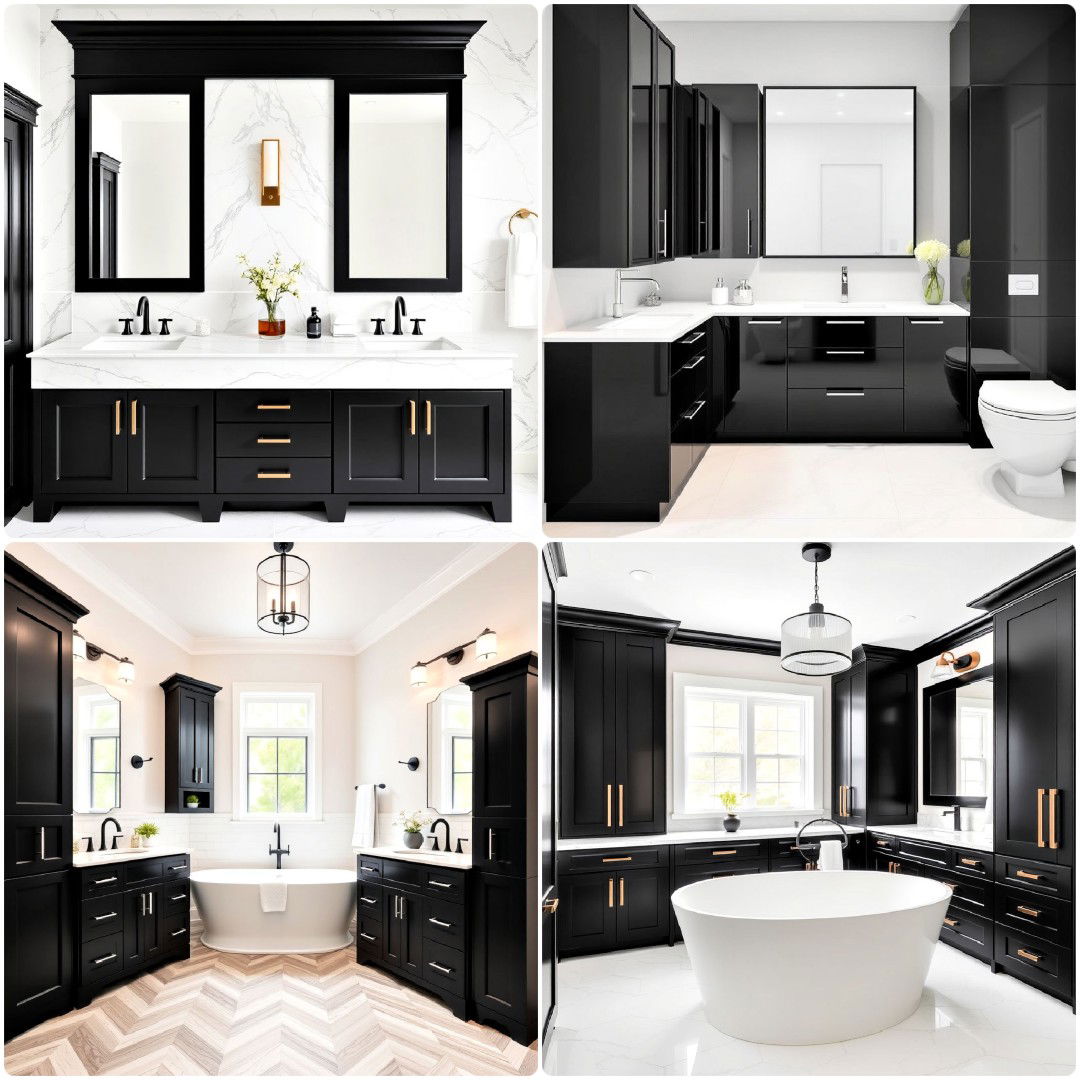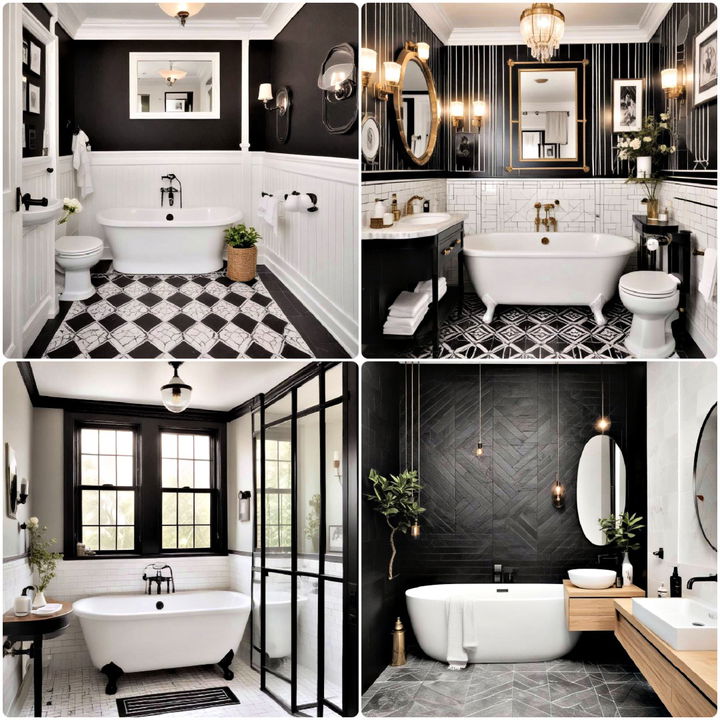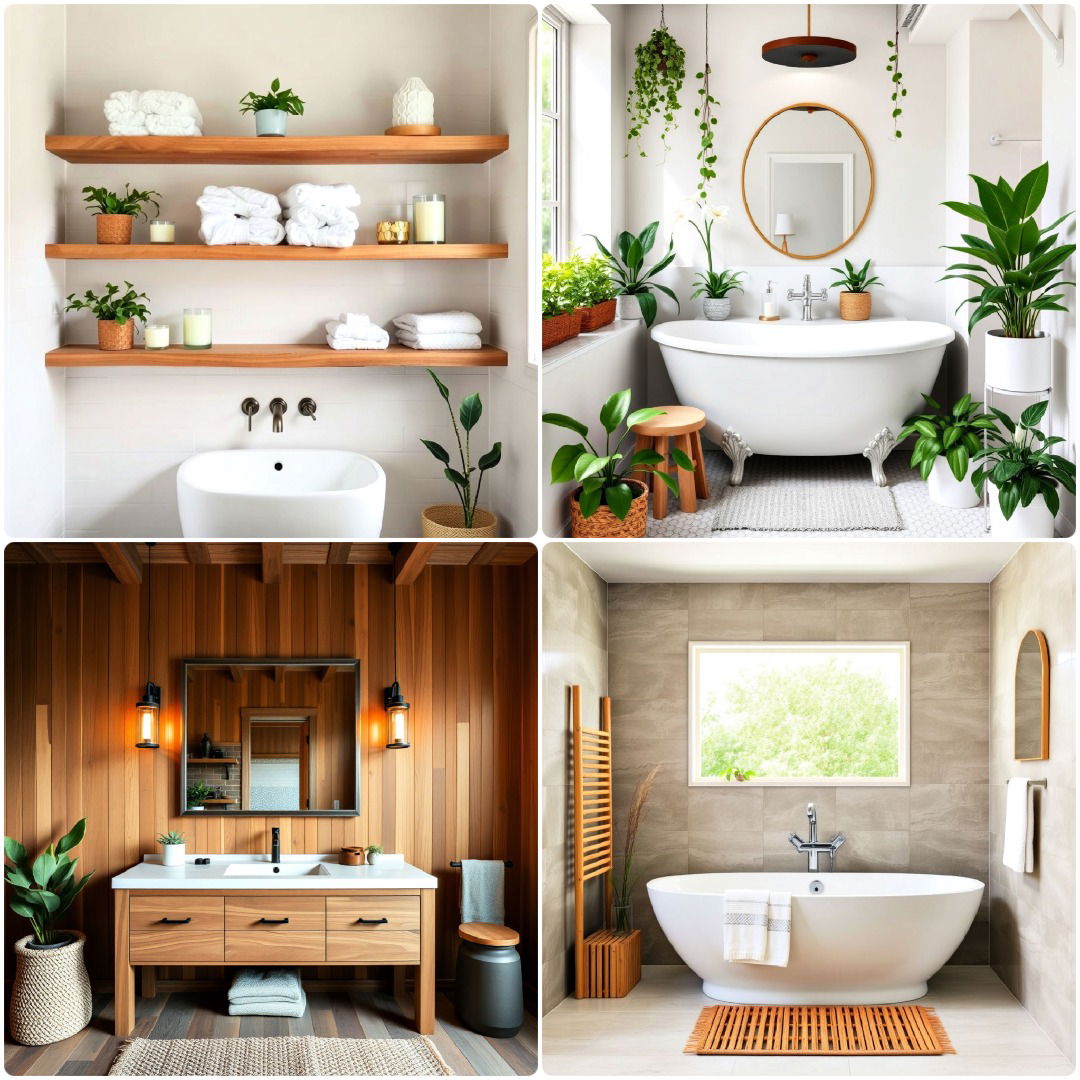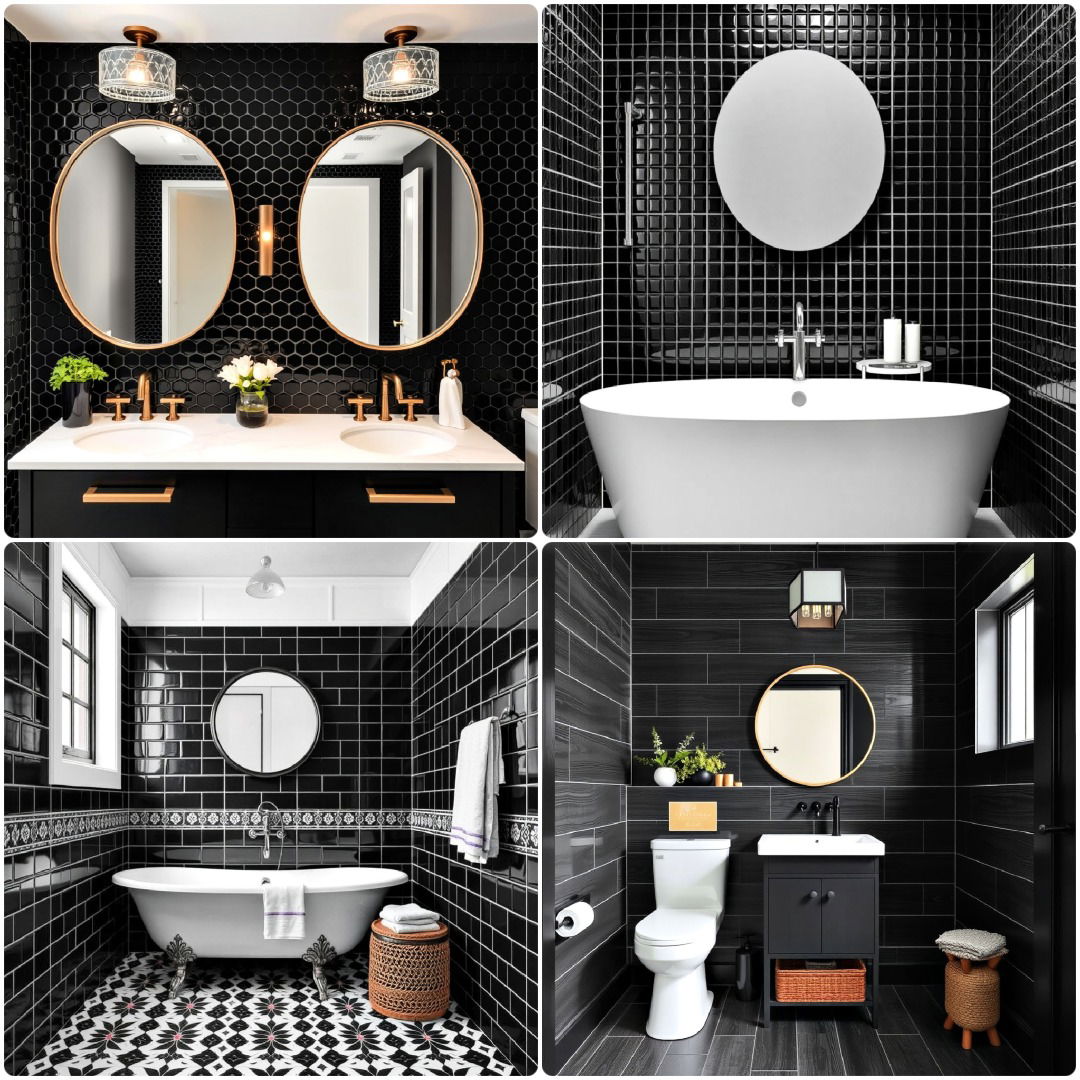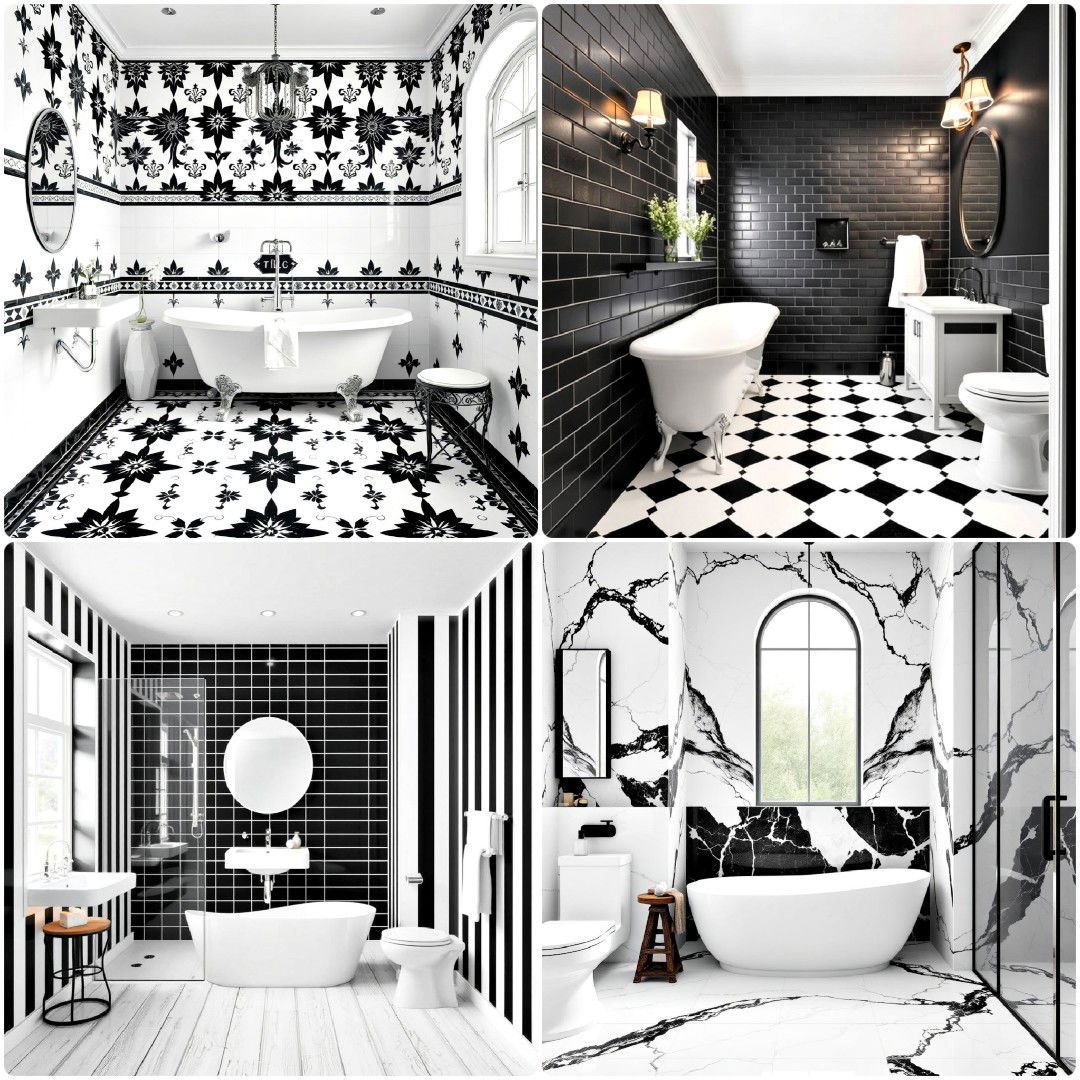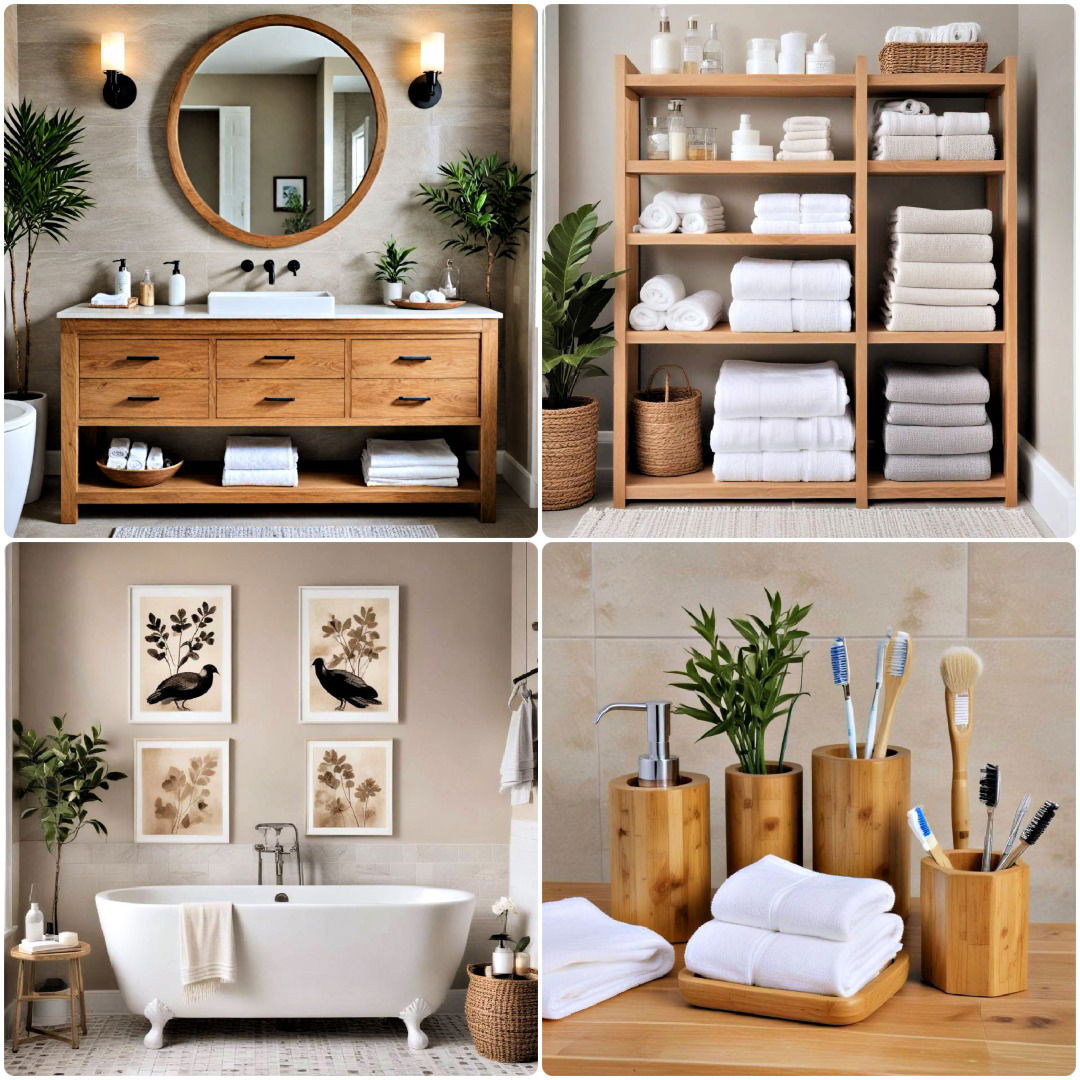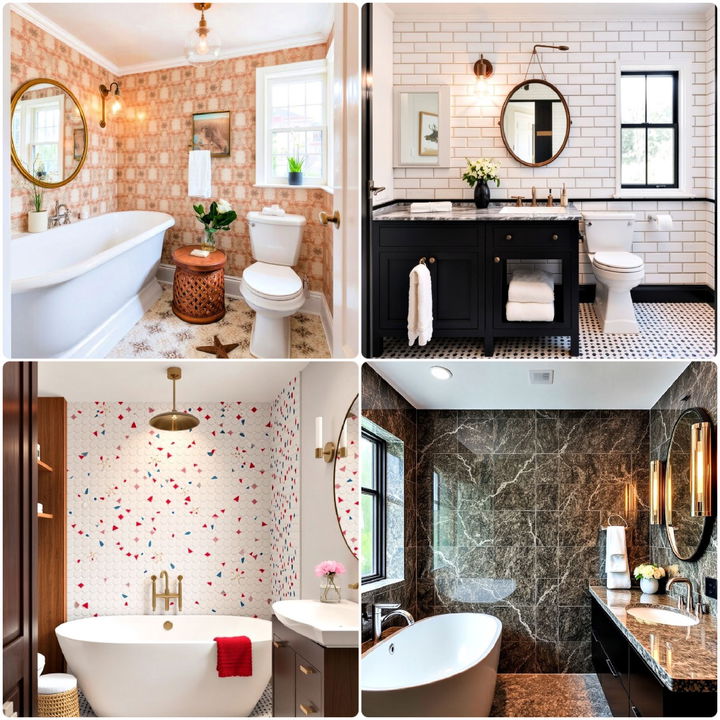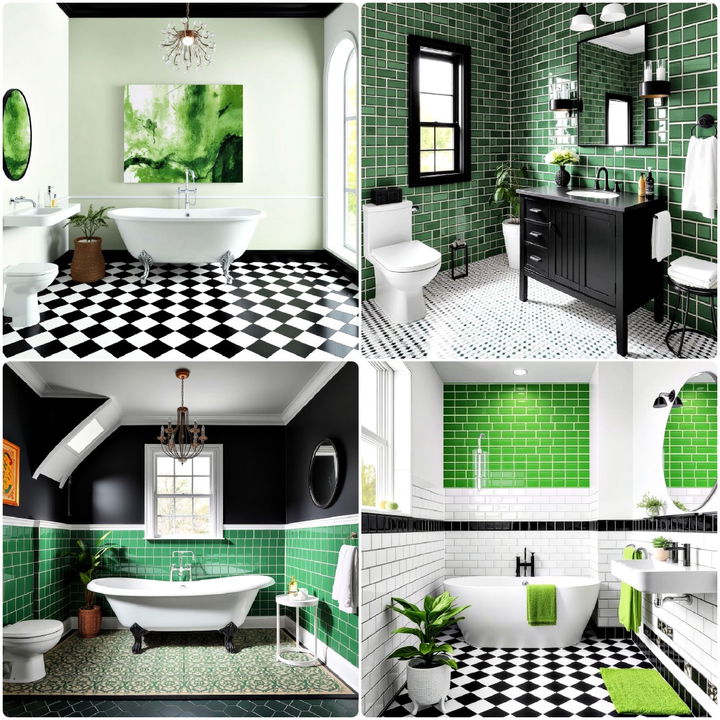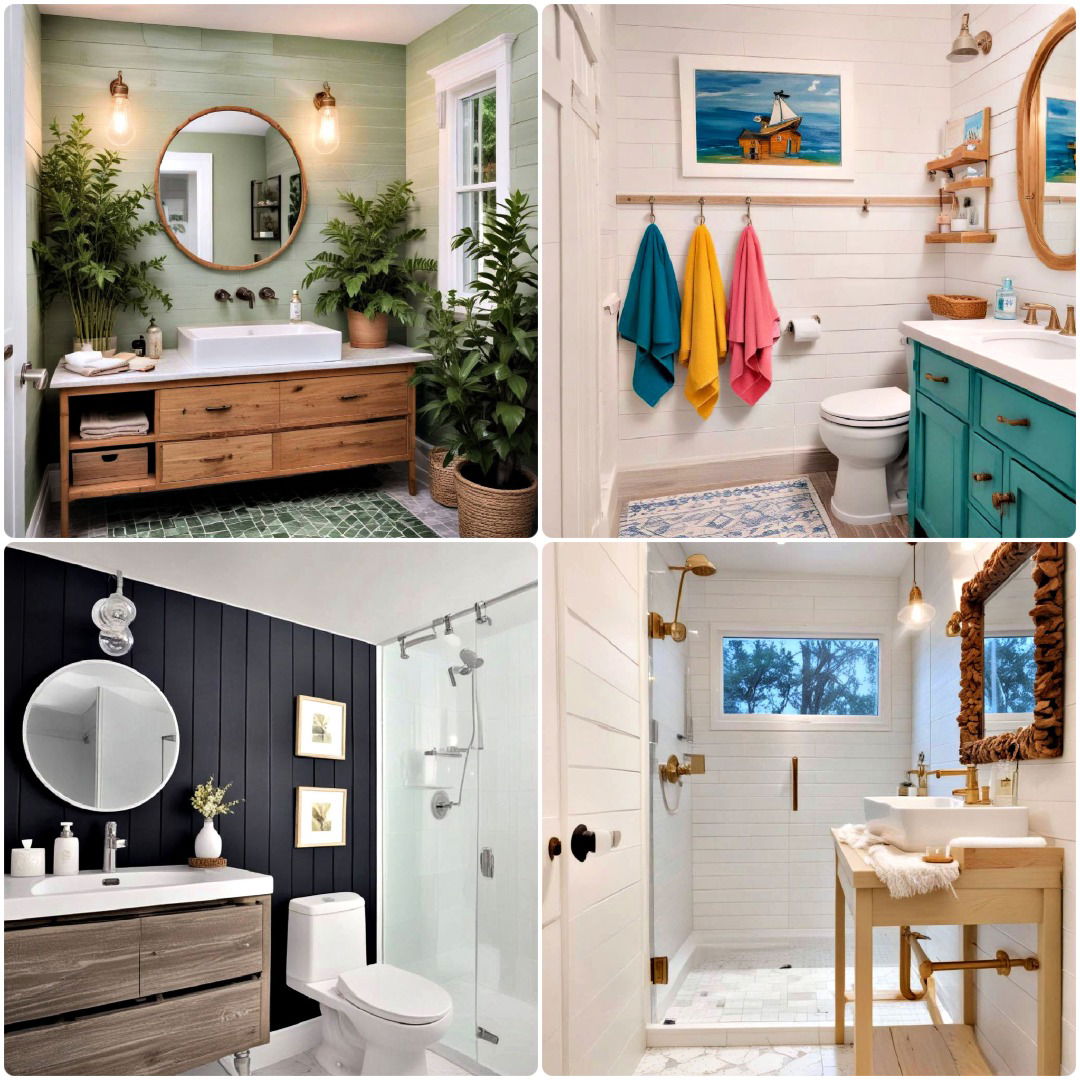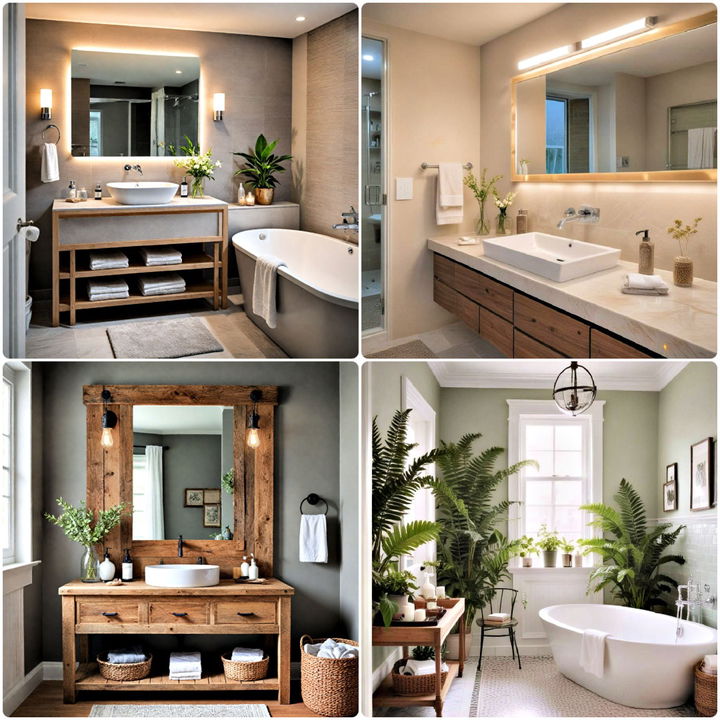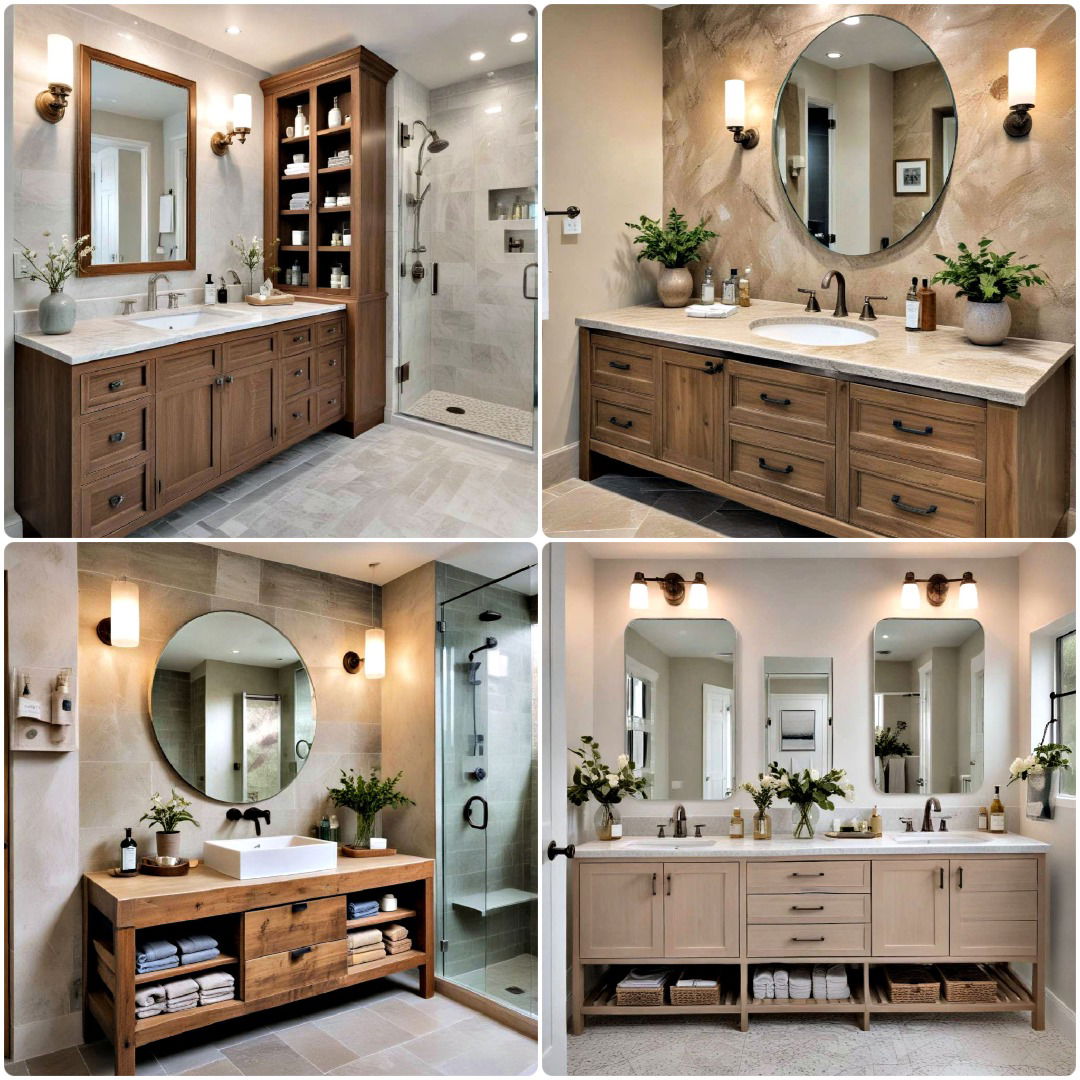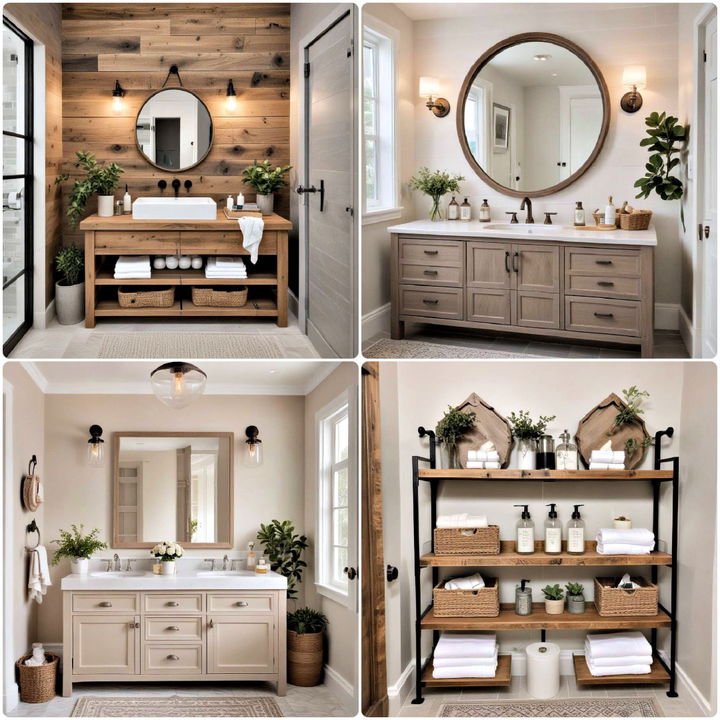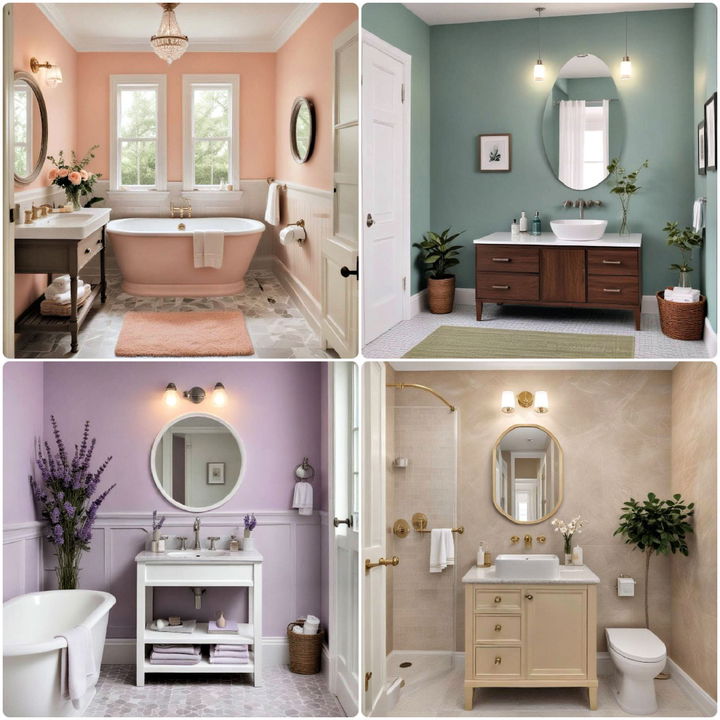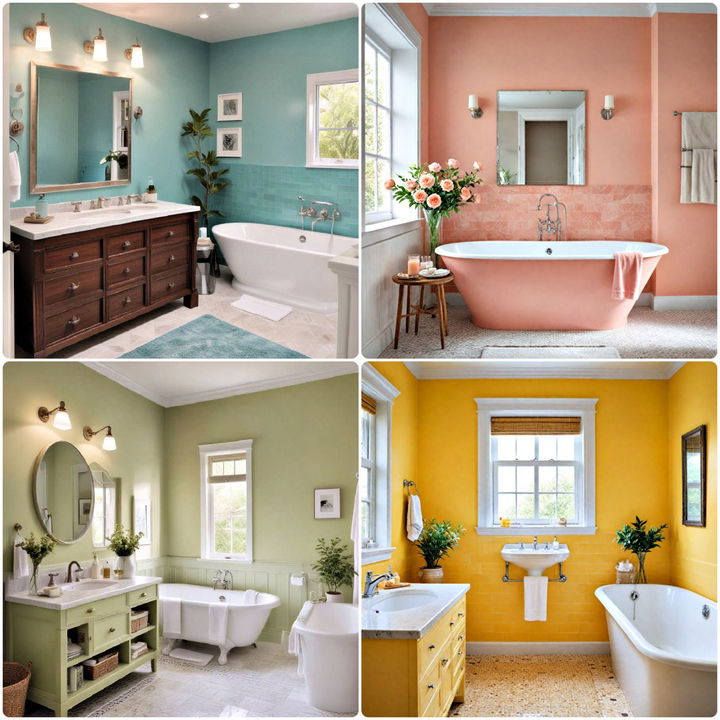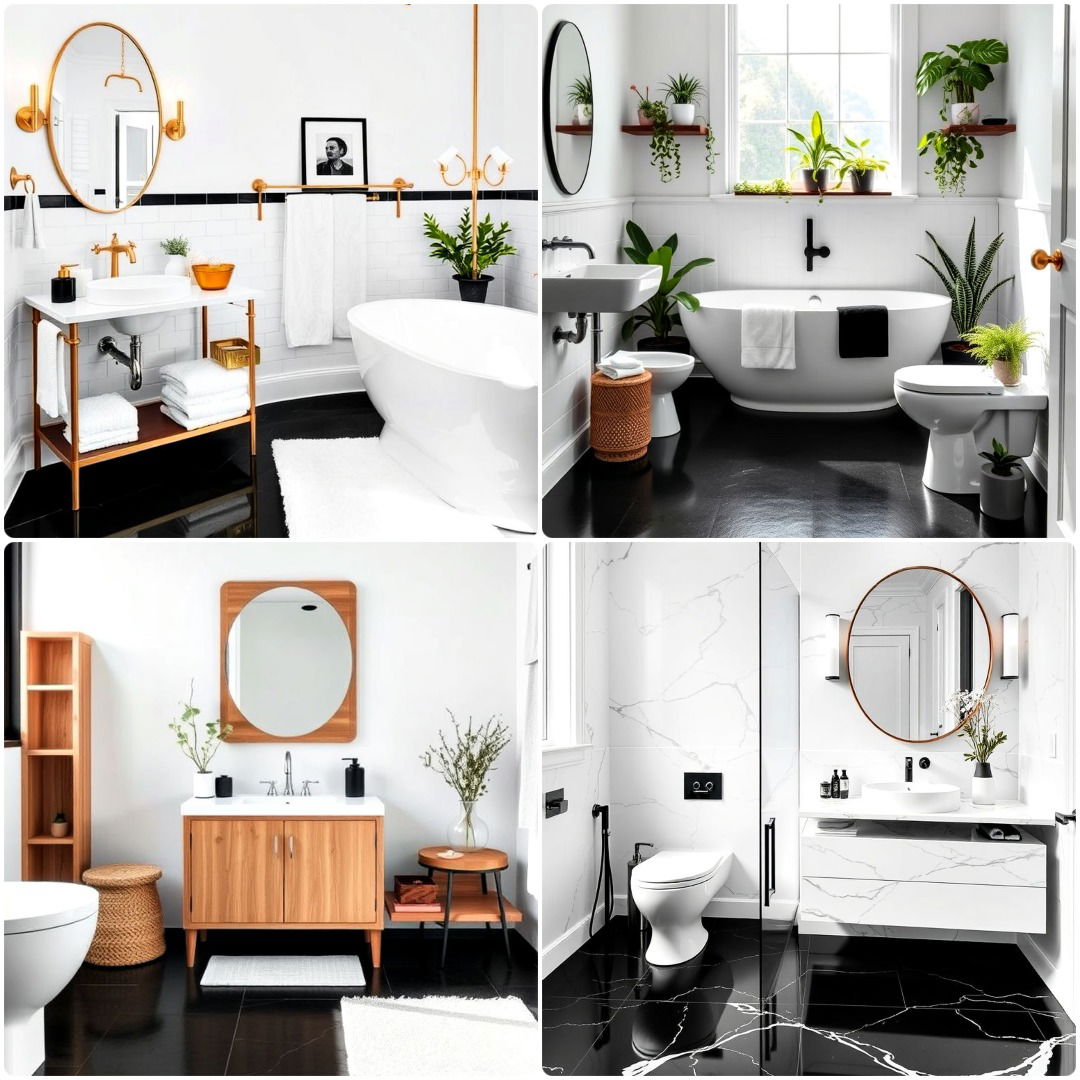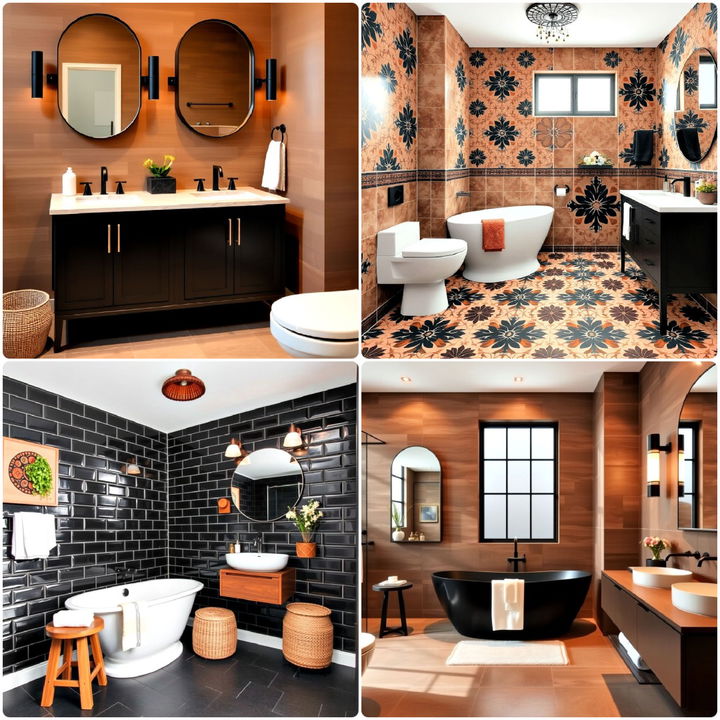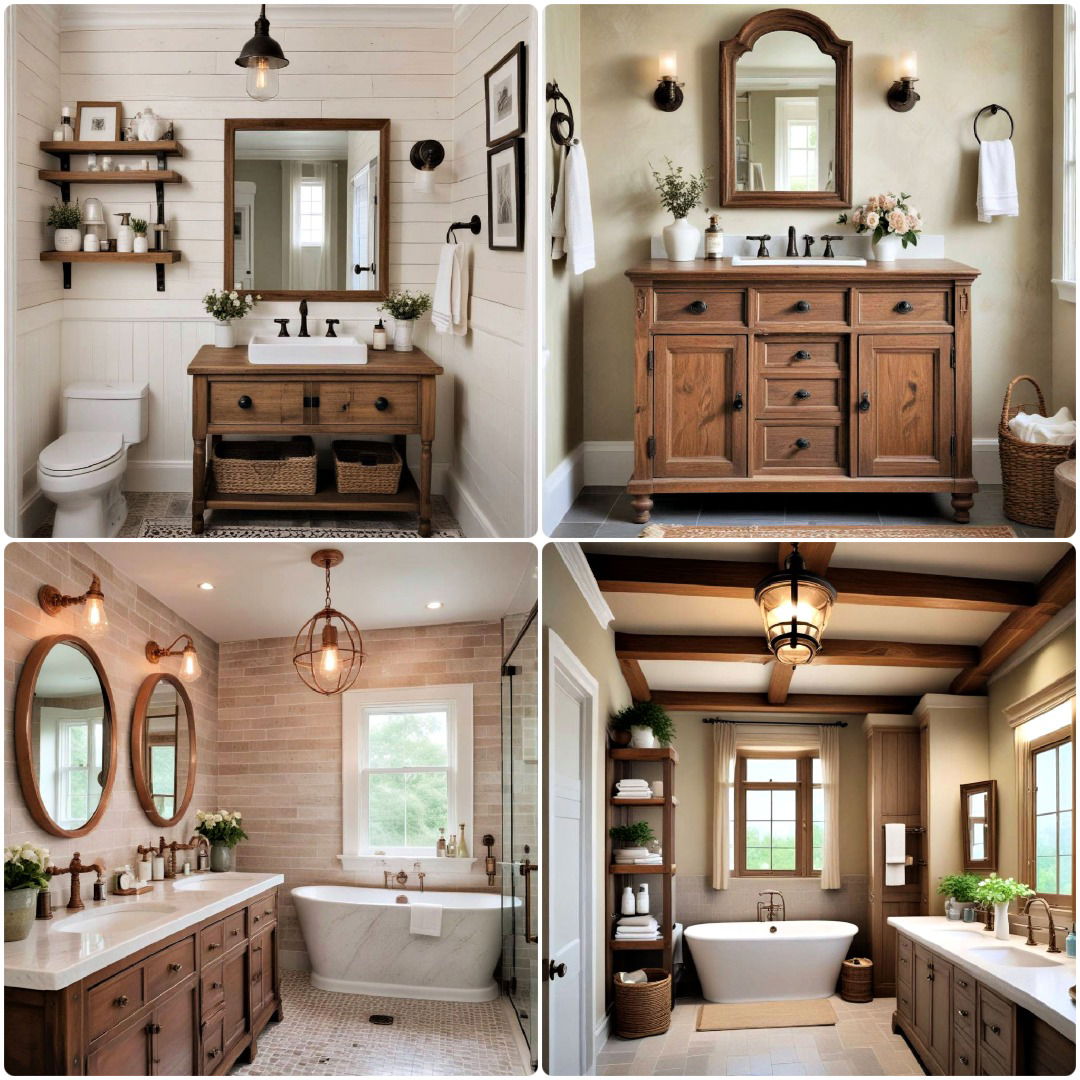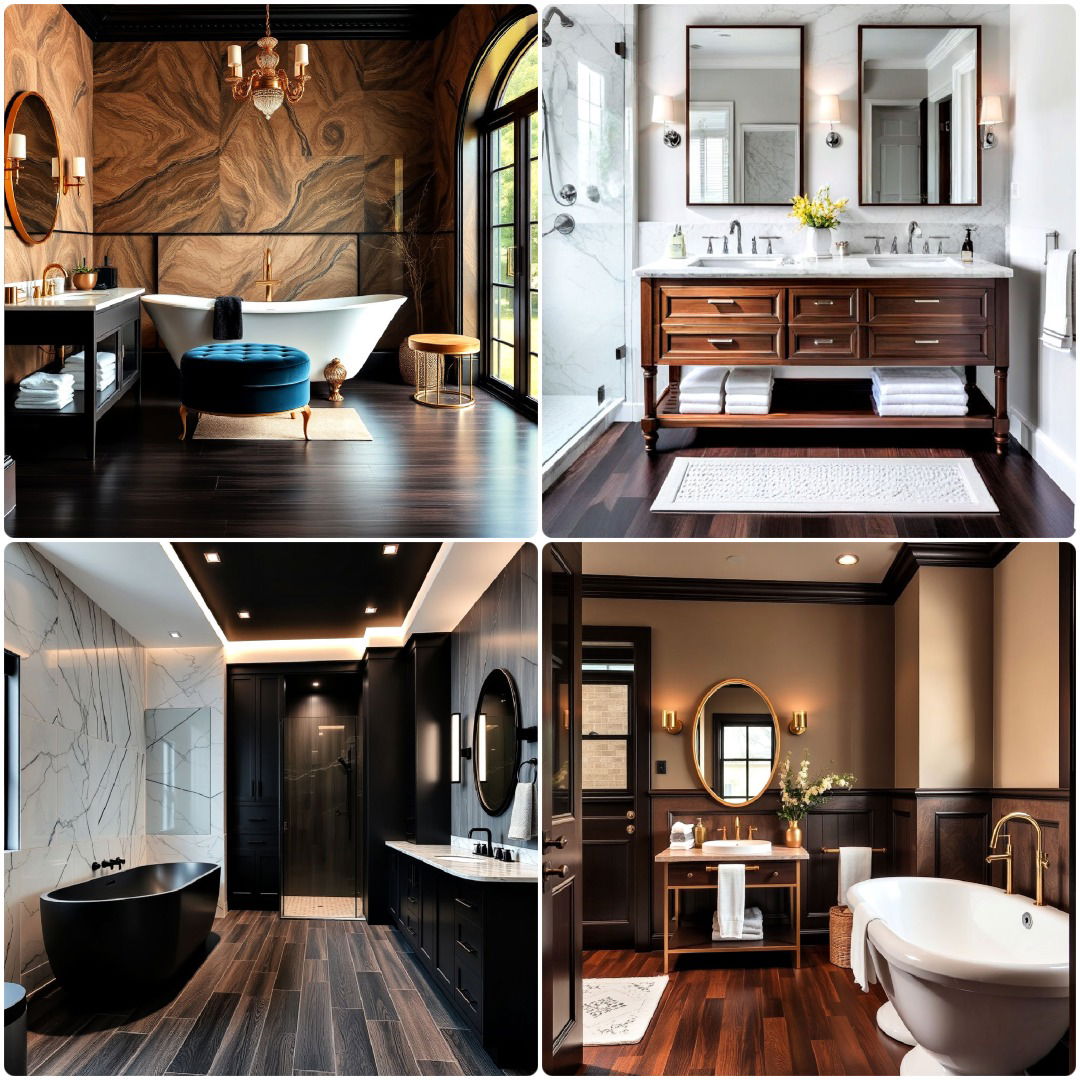Japandi design is the perfect fusion of Scandinavian simplicity and Japanese elegance, creating serene and minimalist spaces that feel effortlessly luxurious. Nowhere is this style more impactful than in the bathroom, where clean lines, neutral palettes, and natural elements combine to create a tranquil retreat. By following one of these 40 enchanting japandi bathroom ideas, your bathroom can become a calming sanctuary—one where beauty and functionality seamlessly intertwine. Whether you’re drawn to the warmth of wooden accents or the understated sophistication of matte black fixtures, the possibilities are endless for creating a minimalist space that feels both inviting and modern.
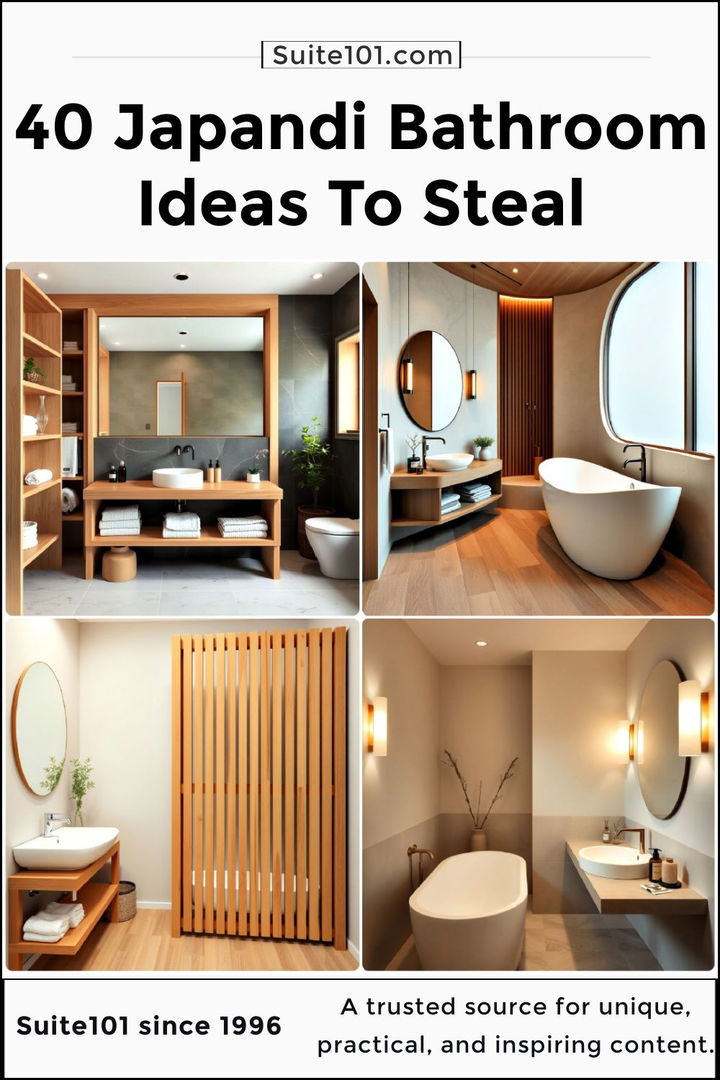
1. Neutral Color Palette with Warm Tones

Japandi bathrooms thrive on simplicity, and using a neutral color palette creates a serene atmosphere. Warm whites, soft greys, and light beige tones evoke a calming environment, perfect for relaxation. These neutral hues provide a subtle backdrop that complements both Japanese and Scandinavian styles. Wood elements, such as light oak or bamboo, can enhance the natural warmth, making the bathroom feel cozy and inviting without overwhelming the space.
2. Minimalist Floating Vanity
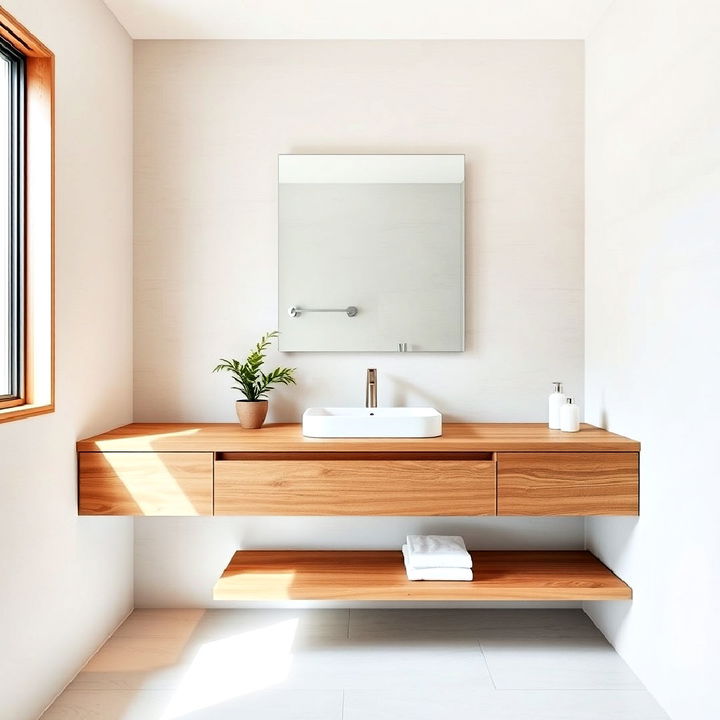
A floating vanity is a must for a Japandi-inspired bathroom. This sleek design gives the illusion of more space while maintaining a minimalist aesthetic. The lack of visible legs allows for easy cleaning and an airy look. Pairing a wood vanity with matte black or brushed metal fixtures ties in Japandi's natural and modern fusion. The simplicity in design emphasizes functionality without compromising style.
3. Freestanding Bathtub as a Centerpiece
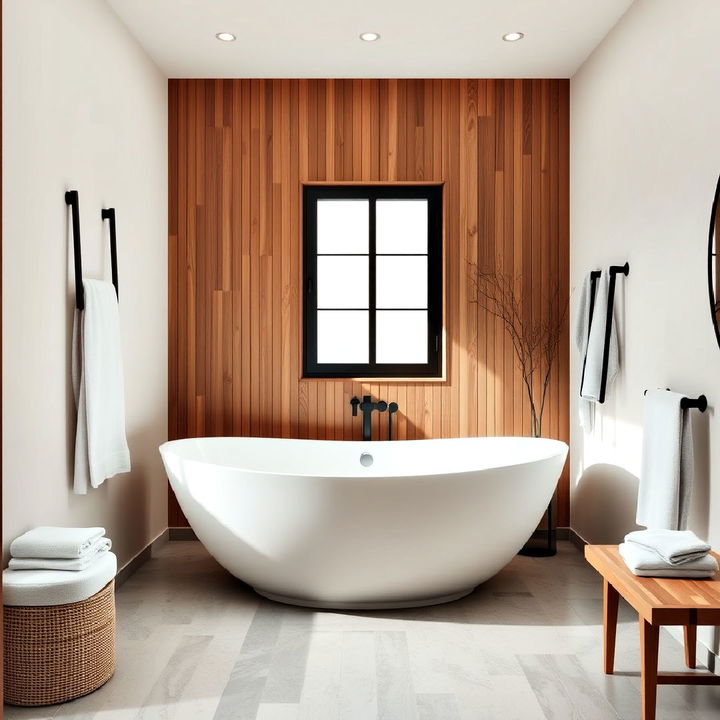
Explore Japandi bathroom ideas that combine minimalism and warmth for a serene, functional space. At the heart of a Japandi bathroom, a freestanding bathtub serves as both a functional and aesthetic focal point. Its sleek, curved shape reflects the Japanese love for bath culture and the Scandinavian embrace of simplicity. Placing the tub in a well-lit, open area enhances the sense of relaxation and luxury. Opt for a minimalist design in natural materials like stone or wood to reinforce the peaceful ambiance.
4. Wooden Accents for Warmth
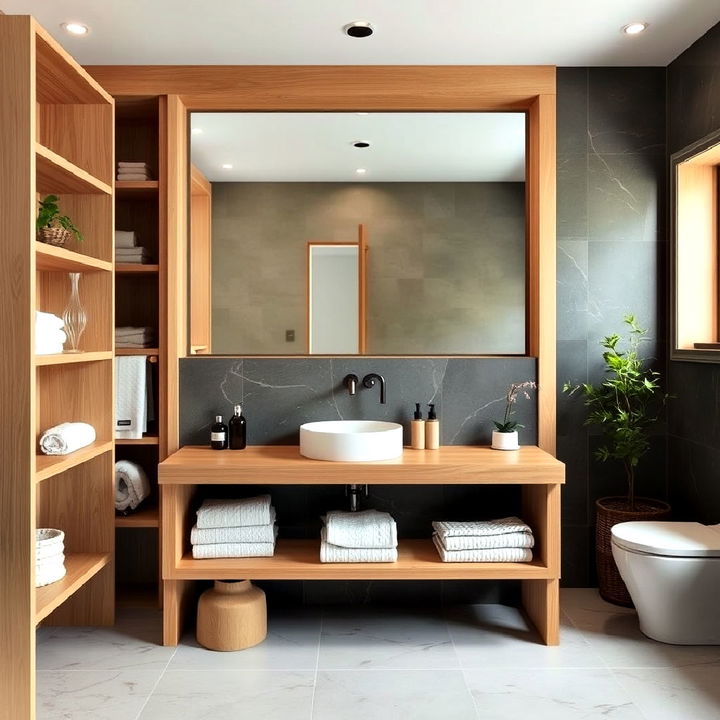
Incorporating wooden accents into your Japandi bathroom adds a layer of natural warmth. Light woods, such as bamboo or oak, can be used in shelving, vanity tops, or even bath mats. The key is to keep the wood untreated or lightly varnished, allowing its natural texture to shine. This understated elegance aligns with both the Scandinavian and Japanese principles of blending nature with functionality.
5. Large Format Tiles
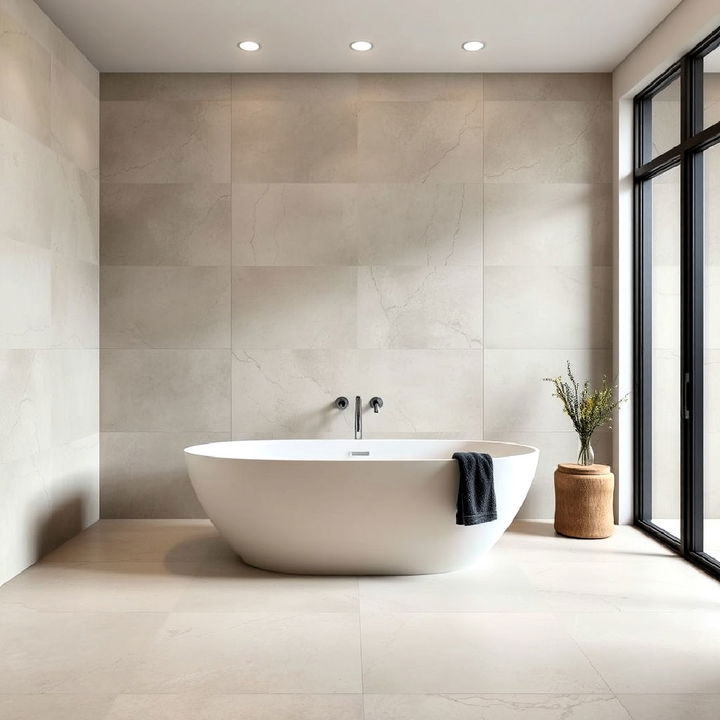
Opt for large-format tiles in neutral shades to create an expansive and streamlined look in the bathroom. These tiles reduce grout lines, giving the walls and floor a more cohesive and clean appearance. Stone-like textures or concrete finishes work particularly well in Japandi designs, as they add an organic, calming feel. The minimalist approach to tiling ensures that the space remains uncluttered and harmonious.
6. Open Shelving with Natural Materials
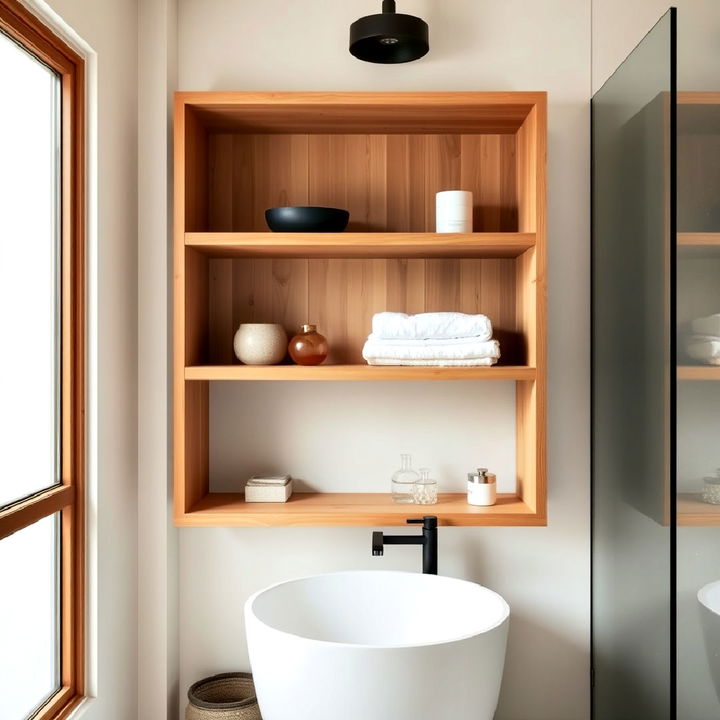
Open shelving offers practical storage while maintaining the minimalistic aesthetic central to Japandi design. Shelves made from wood, stone, or bamboo are perfect for displaying bathroom essentials like towels and decorative elements. Keeping the shelves clean and uncluttered reflects the philosophy of intentional living. The balance of natural materials and functionality creates a serene environment.
7. Low-Profile Lighting
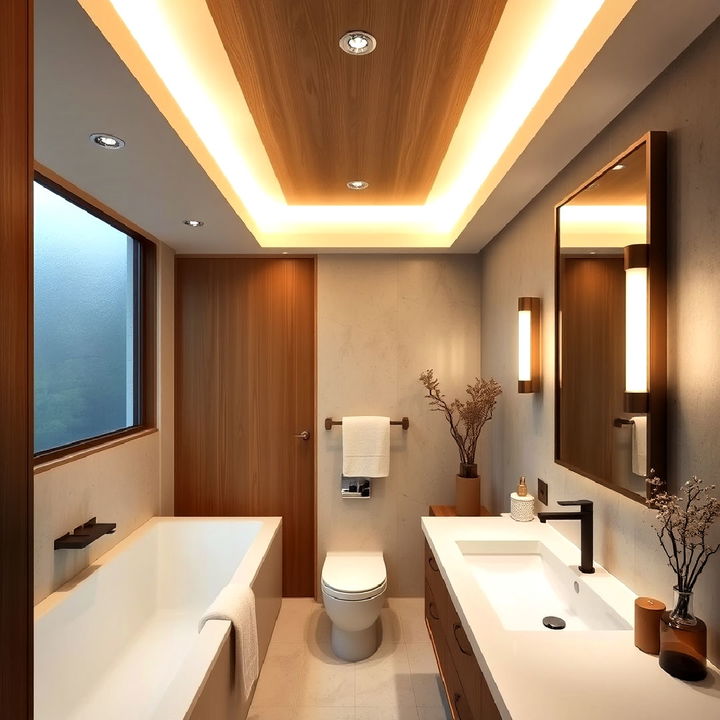
Soft, ambient lighting is essential in creating a peaceful Japandi bathroom. Low-profile light fixtures such as recessed lighting or wall sconces made from natural materials help maintain a minimalist, unobtrusive look. Opt for warm white bulbs to enhance the relaxing atmosphere. A focus on diffused, soft light ensures the space feels intimate and tranquil.
8. Indoor Plants for Natural Zen
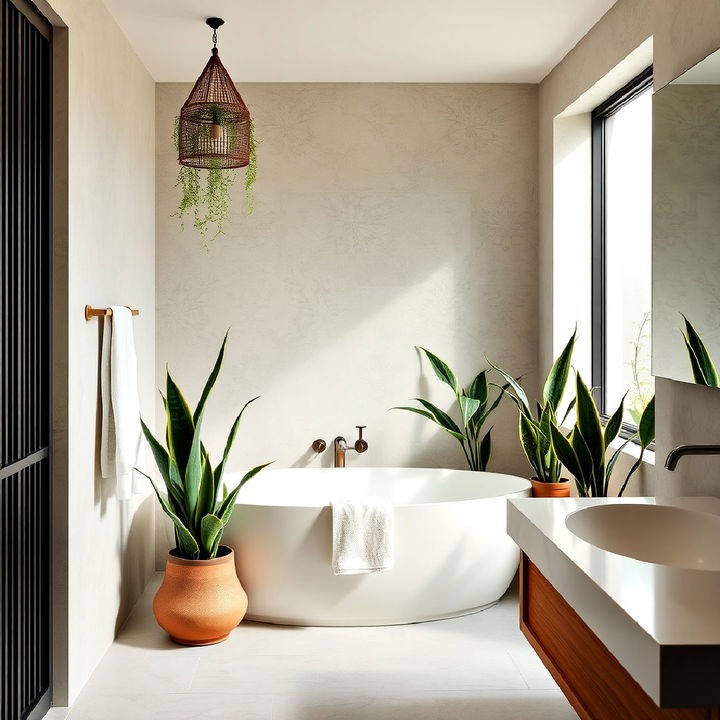
A Japandi style bathroom balances Scandinavian simplicity with Japanese elegance for a calming retreat. Bringing a touch of greenery into the Japandi bathroom can instantly elevate the sense of peace and connection to nature. Simple, low-maintenance plants like ferns, snake plants, or bamboo fit seamlessly into the design. Choose neutral-colored or clay pots to blend with the minimalist aesthetic. The addition of plants not only freshens the air but also enhances the calming, spa-like feel of the bathroom.
9. Matte Black Fixtures
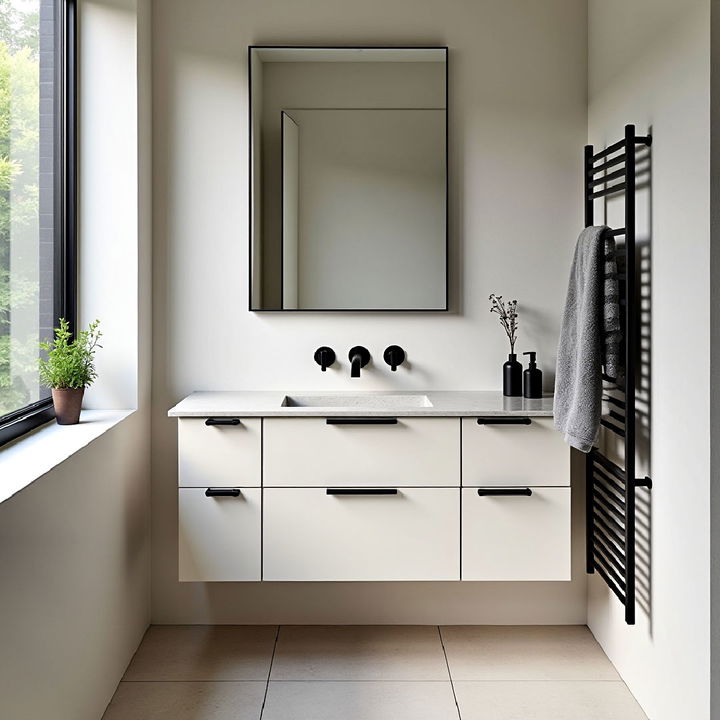
Matte black fixtures are a great way to add contrast to the neutral tones of a Japandi bathroom. From faucets and showerheads to towel bars and cabinet handles, these sleek details provide a modern touch without overpowering the space. The matte finish keeps the look understated, aligning with the Japandi focus on simplicity and elegance, while the black tone offers visual depth.
10. Stone Basin Sinks
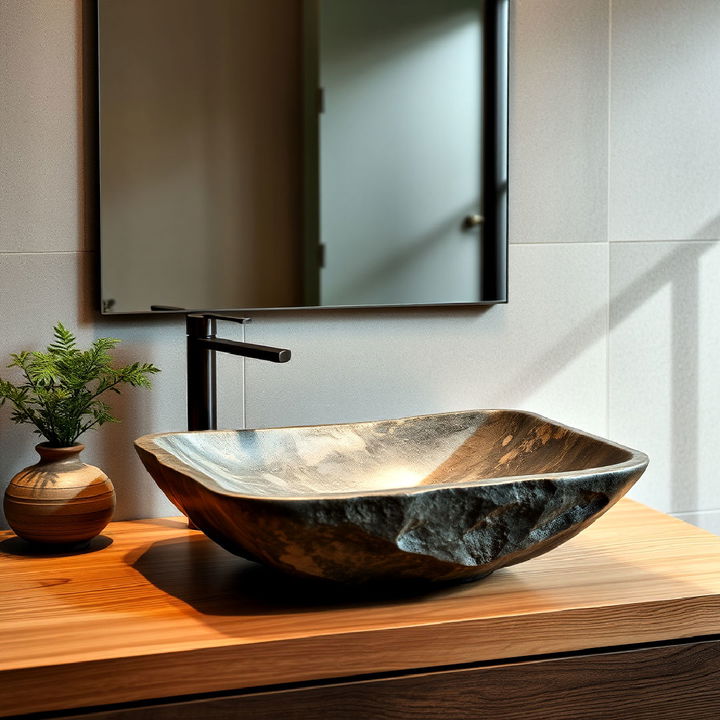
A stone basin sink can serve as a striking yet harmonious feature in a Japandi bathroom. Natural stone, with its raw texture and organic feel, embodies the design's connection to nature. These sinks are often crafted in simple, geometric shapes, blending effortlessly with minimalist interiors. Whether placed on a wooden vanity or a stone countertop, a stone sink elevates the space's serene, natural atmosphere.
11. Soft Linen Textures
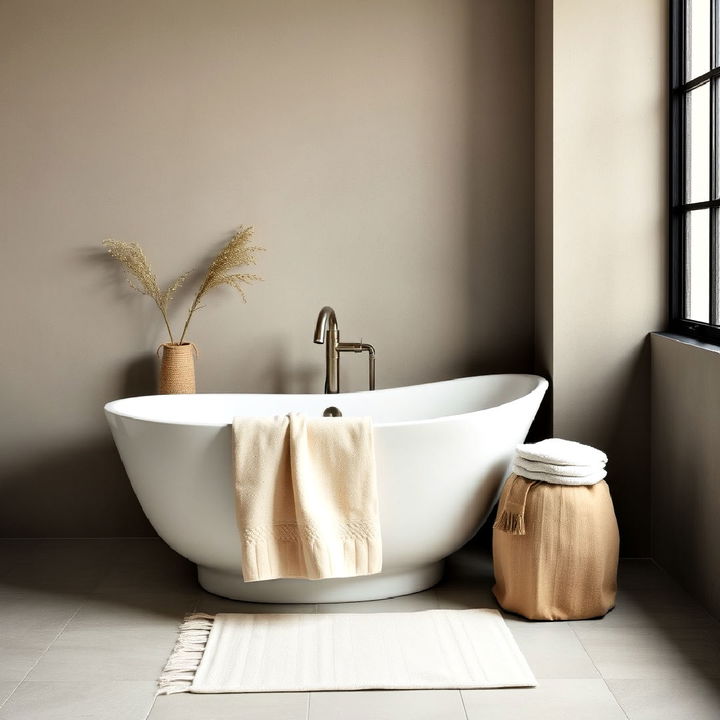
Soft linen towels and bath mats in neutral shades add a subtle layer of comfort and texture to the Japandi bathroom. The natural fibers of linen are lightweight, breathable, and fit the earthy, minimalist aesthetic. Choosing organic or lightly textured linen reinforces the simplicity and elegance of the space, while also contributing to a more eco-friendly bathroom environment.
12. Frameless Glass Shower Enclosure
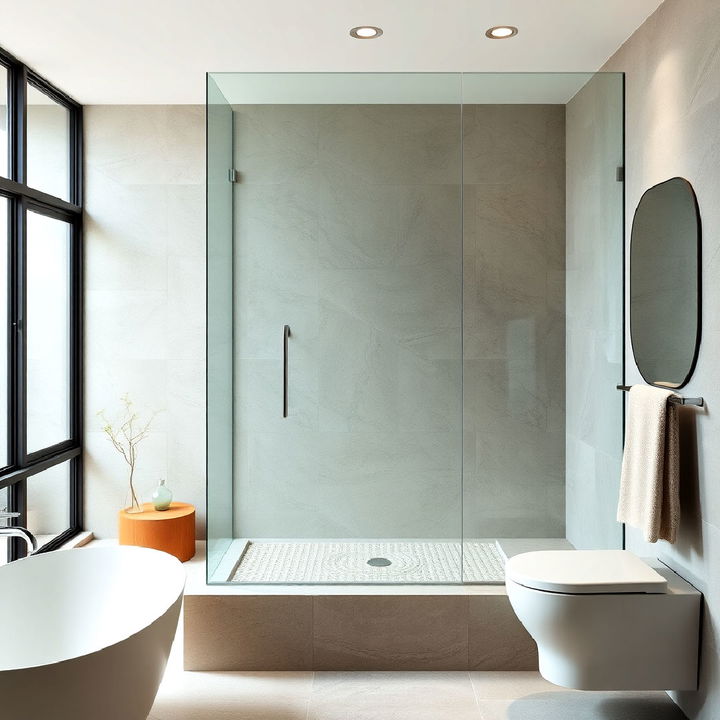
A frameless glass shower enclosure creates a seamless and open look in a Japandi bathroom. The clean lines of the glass enhance the minimalist design while allowing light to flow through the space, making it feel larger and more airy. The lack of framing helps maintain an uncluttered appearance, allowing the other elements of the bathroom, like the stone or wood accents, to stand out.
13. Pebble Flooring for a Natural Touch
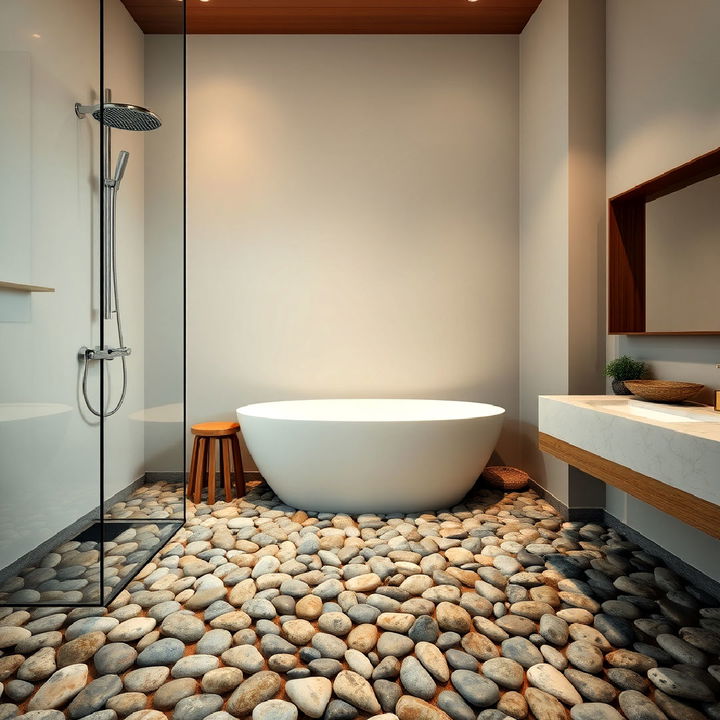
Introduce pebble flooring in your shower area or as a border around the tub to bring a tactile, natural element into the Japandi bathroom. The irregular shapes and smooth textures of the stones evoke the serenity of a Japanese garden, while still maintaining a minimalist aesthetic. This small detail adds a spa-like feel and grounds the bathroom in nature, enhancing the overall sense of calm.
14. Wooden Bath Tray for Practicality
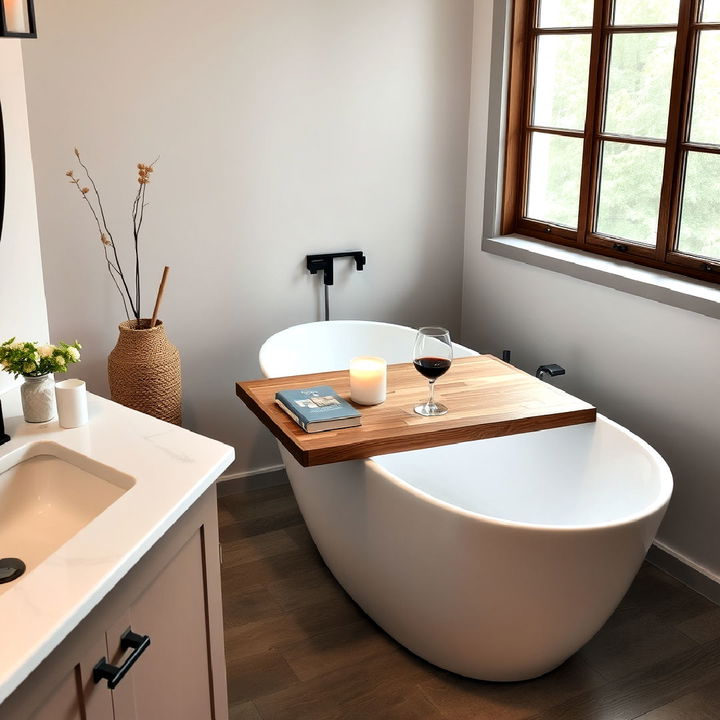
Japandi bathroom design emphasizes clean lines, natural materials, and soft tones for a tranquil atmosphere. A wooden bath tray not only adds a functional element but also introduces warmth and texture to the bathroom. It provides a place to hold bath essentials like candles, books, or a glass of wine, enhancing relaxation. The natural wood contrasts beautifully with the smooth, clean lines of a modern freestanding tub, keeping the look both practical and stylish.
15. Floor-to-Ceiling Windows
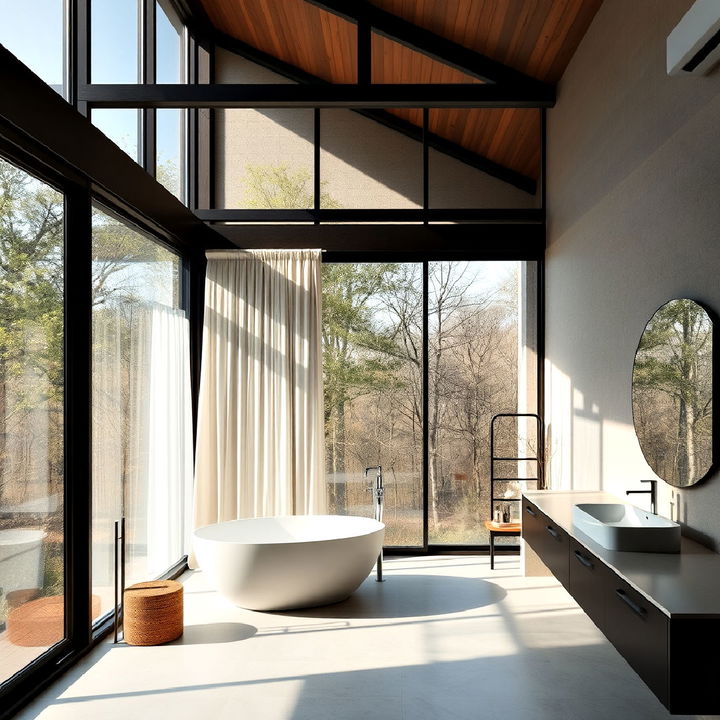
Large windows that let in ample natural light are key to the Japandi aesthetic. Floor-to-ceiling windows can make the bathroom feel connected to the outdoors, enhancing the minimalist, natural vibe. Opt for sheer, neutral-colored curtains or no window treatment at all to keep the look as open and bright as possible. The interplay between light and nature creates a space that feels tranquil and expansive.
16. Simple Geometric Mirrors
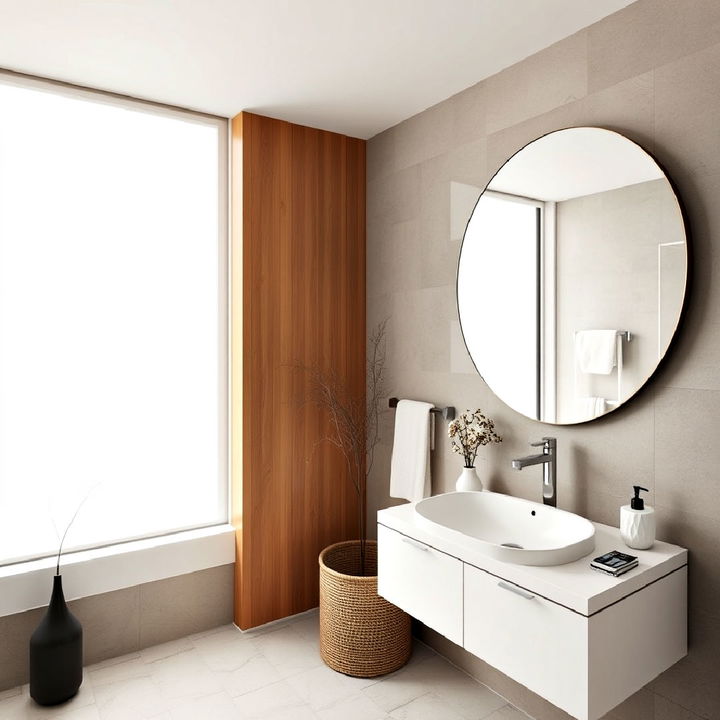
In a Japandi bathroom, mirrors should reflect the simplicity and clean lines of the overall design. Geometric shapes, such as round or oval mirrors, bring softness to the angular lines of the vanity and fixtures. Frameless mirrors or those with thin, matte finishes ensure that they don’t overpower the room. This minimalist approach keeps the space feeling open and uncluttered.
17. Towel Hooks Instead of Bars
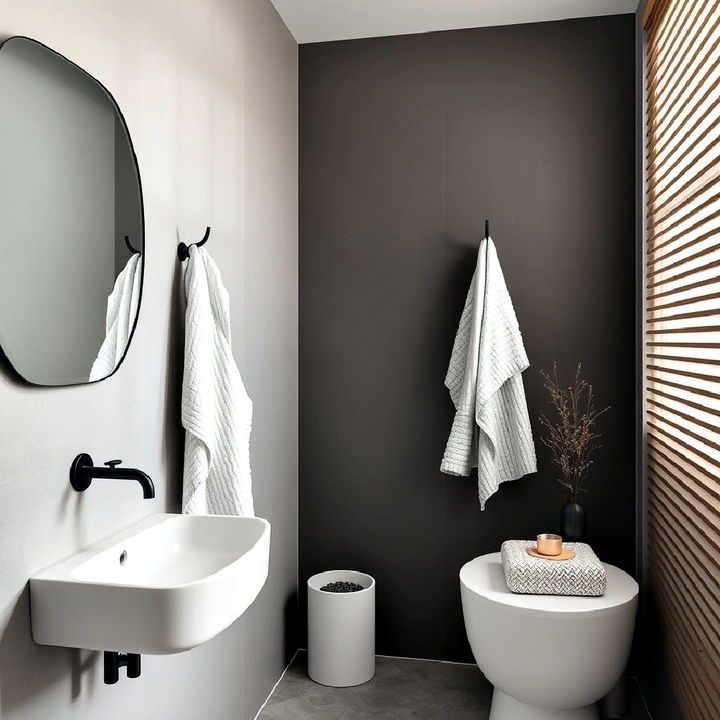
Instead of traditional towel bars, opt for simple towel hooks to keep the design streamlined. Hooks offer a more casual and flexible way to hang towels while maintaining the bathroom’s minimalist vibe. Black or matte metal hooks blend seamlessly into Japandi bathrooms, offering functionality without drawing too much attention. The subtlety of hooks also saves space and reduces visual clutter.
18. Wooden Slat Privacy Screen
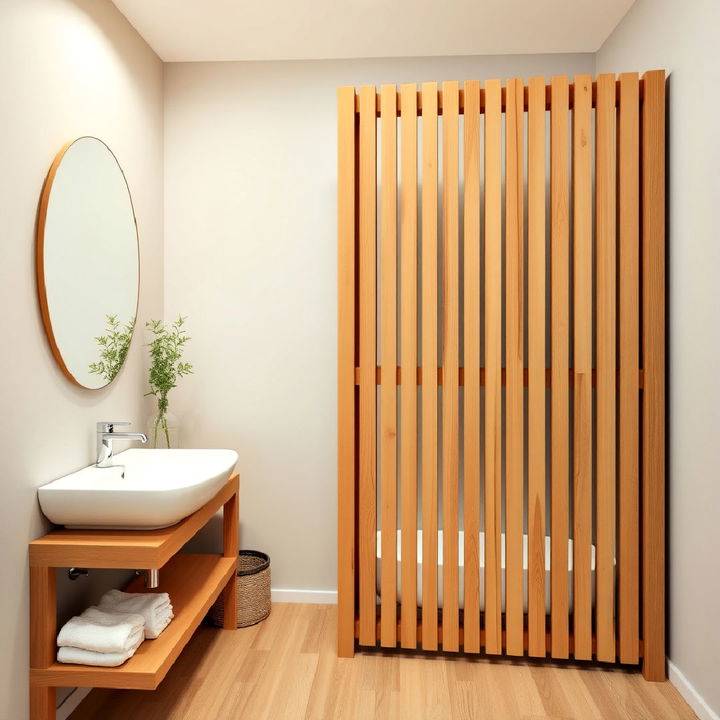
A Japandi shower features minimalist aesthetics and natural elements to create a soothing, spa-like experience. A wooden slat screen is a practical yet stylish addition to any Japandi bathroom. This feature provides privacy without blocking out light, thanks to the open gaps between the slats. Made from light-colored wood, it aligns perfectly with the design’s focus on natural materials. The screen’s simple, elegant construction can also serve as a statement piece, adding texture and warmth to the space.
19. Built-In Niches for Storage
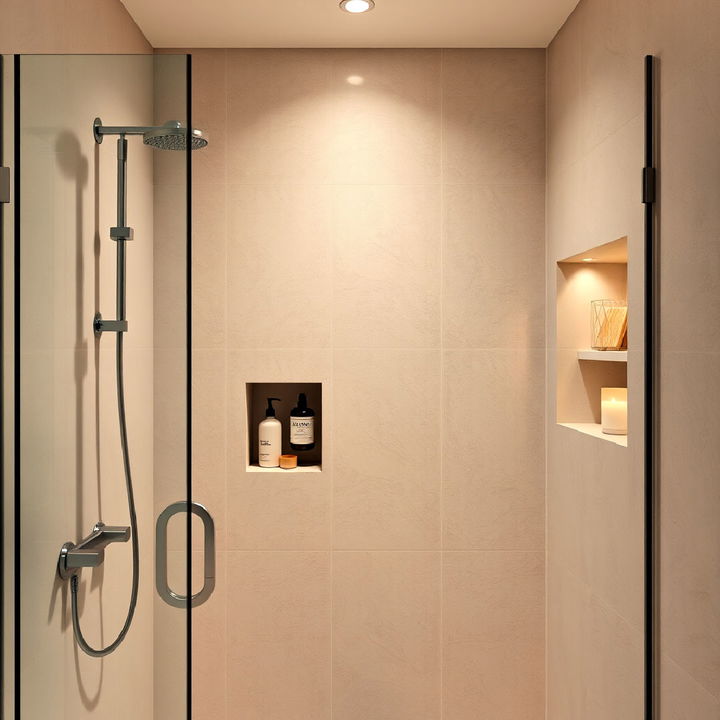
Built-in shower or bath niches provide a sleek storage solution that blends seamlessly into the walls. These recessed shelves offer space for essentials like shampoos, soaps, and candles without the need for bulky storage units. Finished in the same material as the walls, these niches maintain the bathroom’s clean and minimalist aesthetic while adding convenience.
20. Soft, Diffused Lighting
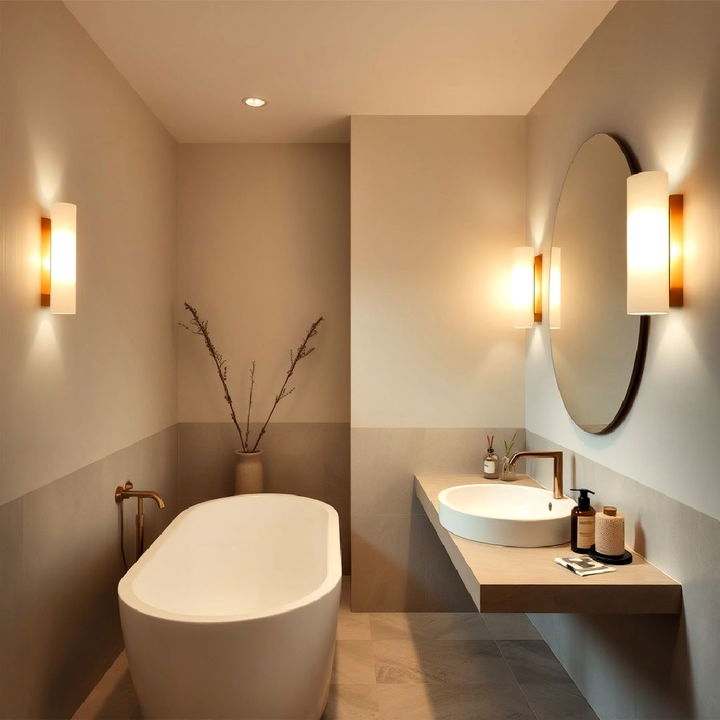
Soft, diffused lighting is essential in creating a serene atmosphere in the Japandi bathroom. Choose frosted or opaque light fixtures to soften the glow and reduce harsh shadows. Wall sconces or under-vanity lighting can also help create a calm and cozy ambiance. This lighting style complements the minimalist, spa-like environment that defines Japandi spaces, enhancing the overall sense of tranquility.
21. Natural Stone Countertops
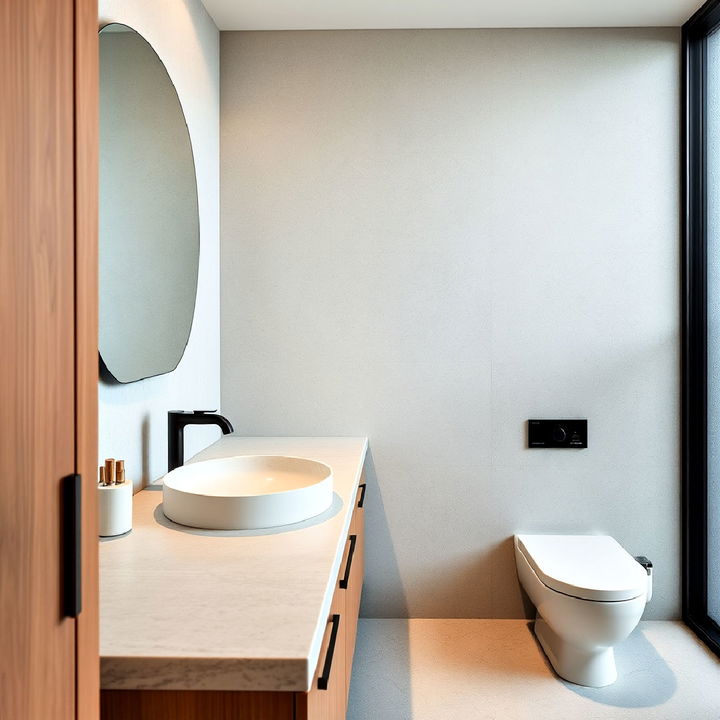
Natural stone countertops are a perfect match for Japandi bathrooms, as they add both elegance and durability. Materials such as marble, granite, or soapstone offer a timeless appeal with their subtle patterns and cool tones. Their natural imperfections create a beautiful contrast with the minimalist design, adding depth and texture without overwhelming the space. A stone countertop paired with simple wood cabinetry or metal fixtures elevates the overall aesthetic while keeping the room grounded in nature.
22. Bamboo Bath Mats

A bamboo bath mat is not only a practical addition but also embodies the Japandi design philosophy of incorporating natural materials. These mats provide a warm, earthy element to the bathroom floor and are highly durable, resistant to moisture, and easy to clean. Bamboo's simple, sleek design aligns with the minimalist aesthetic, while its eco-friendliness appeals to those seeking sustainability. The natural grain of bamboo also adds subtle texture without disrupting the bathroom’s calm atmosphere.
23. Curved Edges for Softer Lines
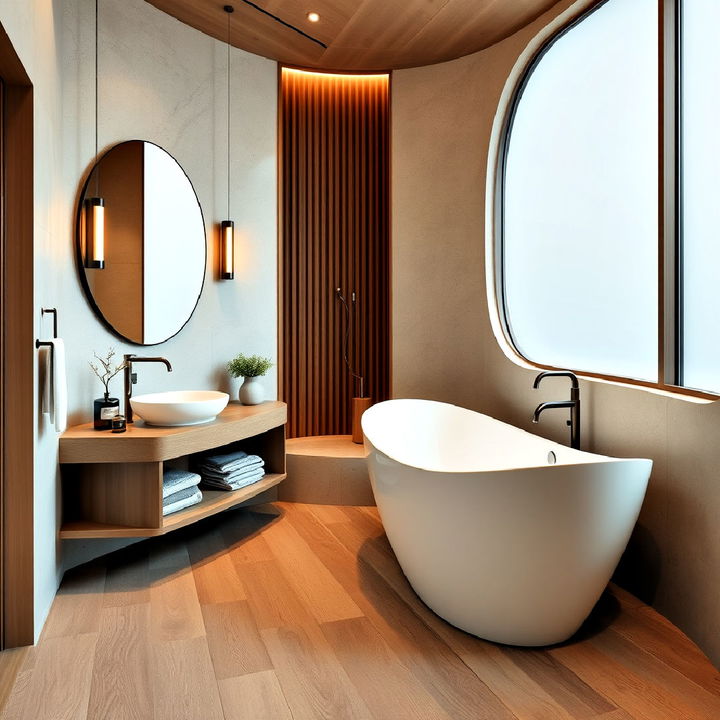
Incorporating curved edges into bathroom elements such as vanities, bathtubs, or mirrors can soften the overall look. Japandi design emphasizes balance, and the introduction of gentle curves brings a sense of tranquility. Curved forms create a calming, flowing feel, contrasting with the rigid lines often found in minimalist designs. This soft touch, paired with natural materials like wood or stone, helps make the space more inviting and peaceful.
24. Black-Framed Shower Doors

Black-framed shower doors are a great way to introduce a subtle, modern contrast to the neutral tones of a Japandi bathroom. The thin, matte black frames provide a contemporary touch, while their minimalist design maintains the clean and open feel of the space. The black detailing draws attention without overwhelming, and it pairs beautifully with other matte black fixtures like faucets or towel hooks. This creates a cohesive, stylish look while preserving the simplicity of the Japandi aesthetic.
25. Soft, Muted Pastels
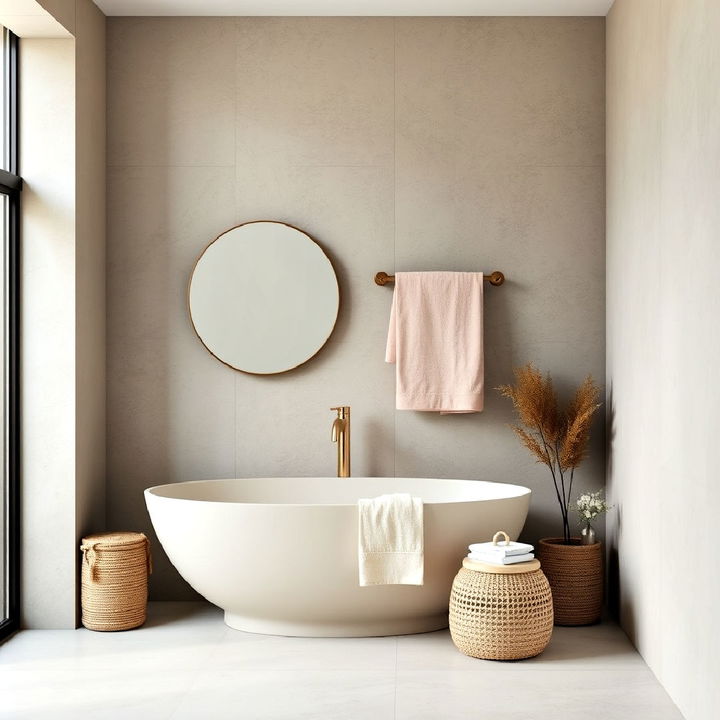
While neutrals dominate Japandi bathrooms, the introduction of soft, muted pastels can add a subtle pop of color without breaking the minimalist aesthetic. Hues like pale sage, blush pink, or muted blues can be incorporated through towels, accessories, or even wall paint. These gentle tones complement the natural materials, providing a refreshing yet harmonious vibe. The key is to keep the colors understated, ensuring they enhance rather than overpower the calming atmosphere.
26. Scandinavian-Inspired Wall Art
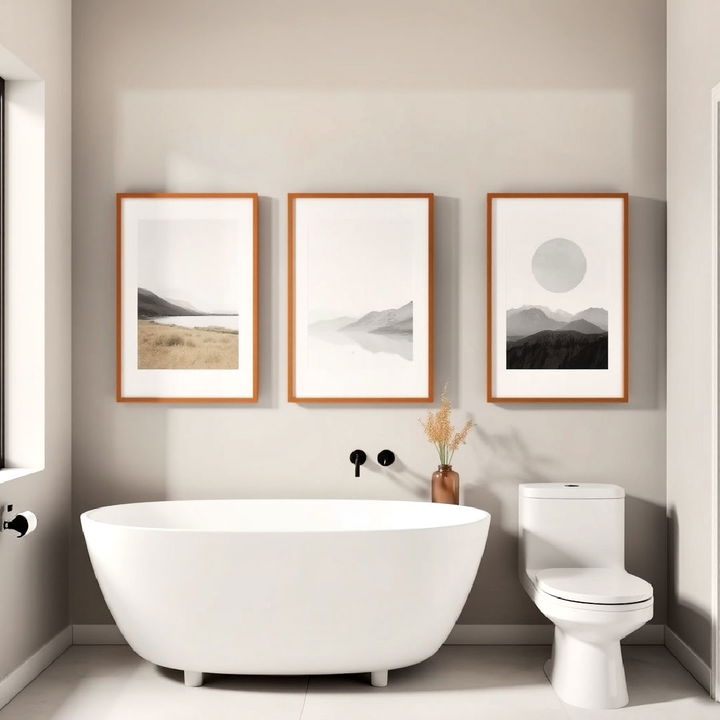
Add a touch of personality to your Japandi bathroom with simple, Scandinavian-inspired wall art. Opt for minimalist prints in neutral tones, featuring natural elements like landscapes or abstract designs. These pieces bring a subtle visual interest without overwhelming the clean, calm aesthetic of the space. Keeping the frames simple—wood or black metal—ensures the artwork blends seamlessly with the rest of the bathroom design, reinforcing the serene and harmonious vibe.
27. Recessed Lighting for a Clean Look
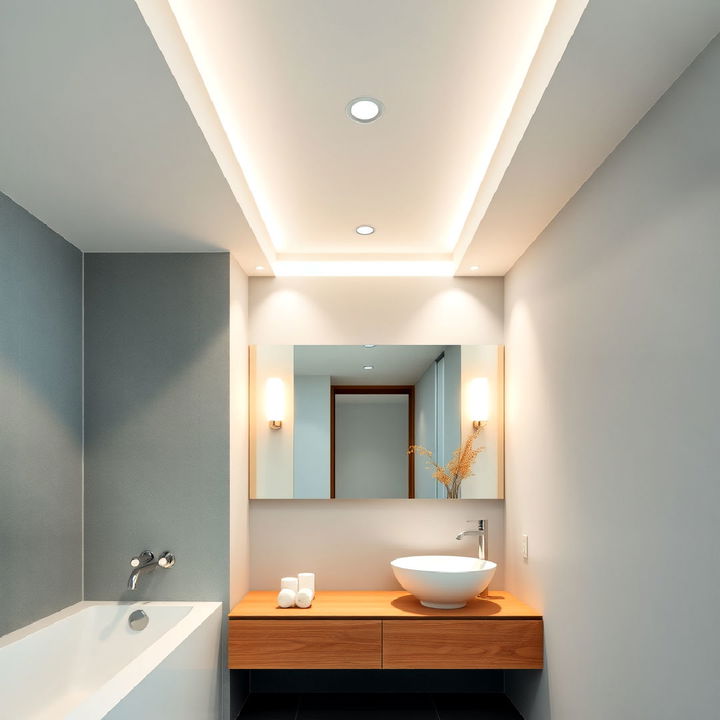
Recessed lighting is an excellent choice for Japandi bathrooms, as it provides a minimalist and unobtrusive source of light. The lights are installed flush with the ceiling, ensuring that the fixtures themselves don’t detract from the clean lines of the bathroom. This style of lighting helps create a soft, even illumination throughout the space, contributing to the peaceful and calming atmosphere characteristic of Japandi design.
28. Natural Fiber Baskets for Storage
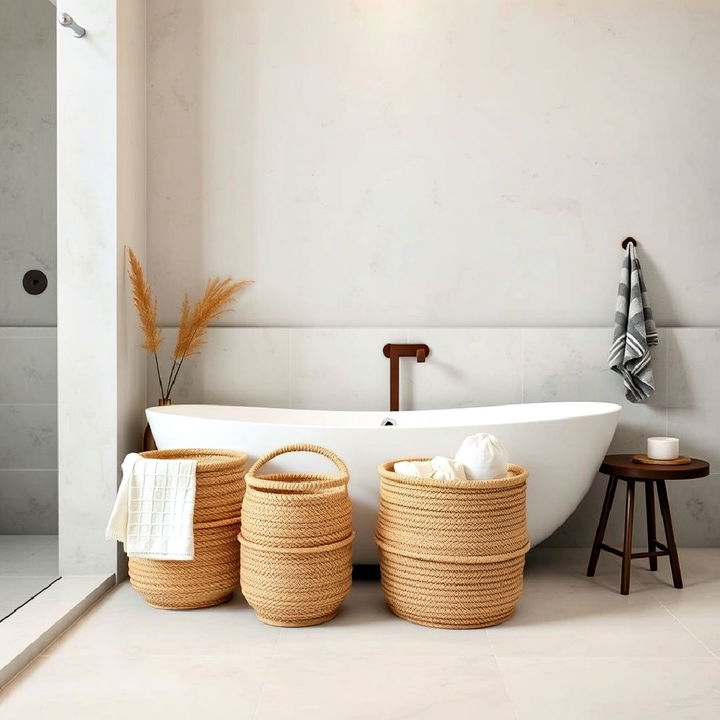
Incorporating natural fiber baskets in your Japandi bathroom provides both functionality and texture. Baskets made from materials like wicker, jute, or rattan are perfect for storing towels, toiletries, or other bathroom essentials while maintaining the minimalist aesthetic. These organic textures contrast nicely with smooth surfaces like stone and tile, adding warmth and a sense of coziness. Their simplicity ensures that they don’t detract from the clean, uncluttered feel of the bathroom.
29. Sliding Wooden Doors
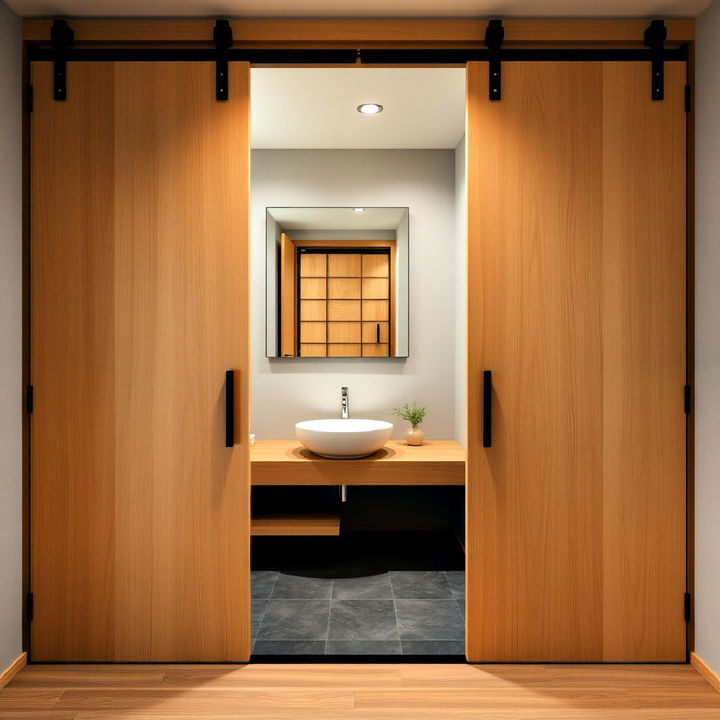
Japandi bathrooms are known for their simplicity, balance, and the use of natural materials to enhance relaxation. Sliding wooden doors are a practical and stylish way to incorporate Japandi design into your bathroom. These space-saving doors often feature natural wood grains and minimalist hardware, enhancing the simplicity and functionality of the space. They provide an elegant transition between the bathroom and adjoining rooms, while the natural material adds warmth. The sliding mechanism also adds a touch of Japanese influence, reminiscent of traditional shoji screens.
30. Organic-Shaped Bath Accessories
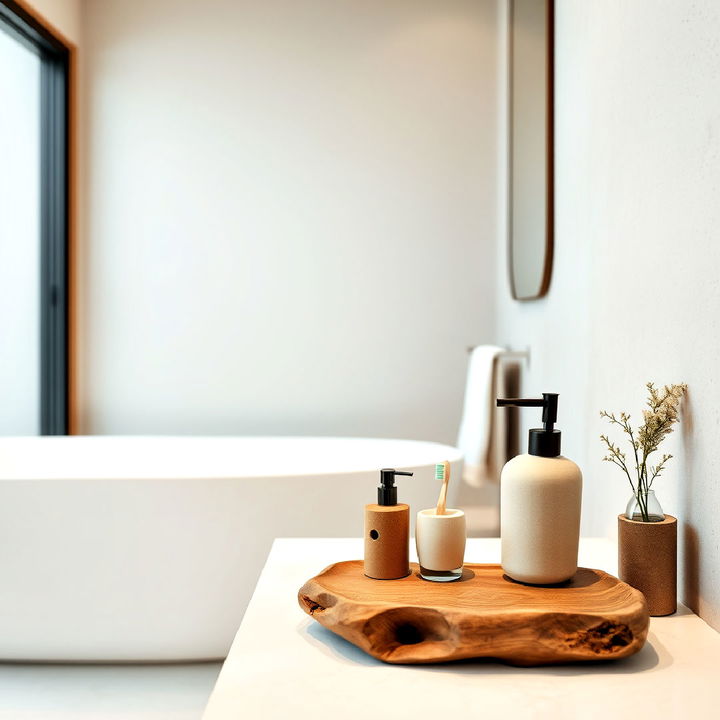
To enhance the organic feel of a Japandi bathroom, opt for accessories like soap dispensers, toothbrush holders, and trays in natural, irregular shapes. Materials like ceramic, stone, or wood work best, as they reinforce the connection to nature. These subtle touches contribute to the overall harmony of the space, adding texture and interest without disrupting the minimalist aesthetic. The key is to keep the designs simple, focusing on form and natural beauty.
31. Low Vanity Lighting
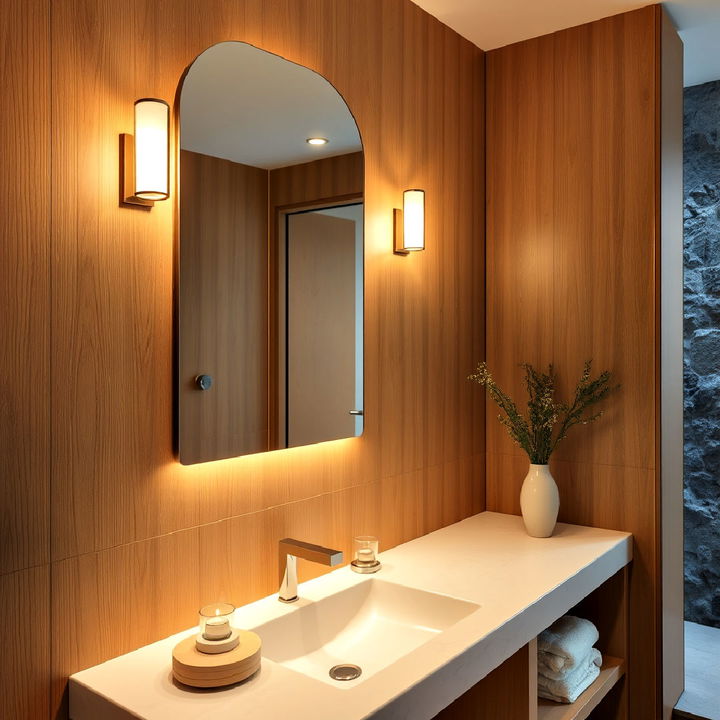
In Japandi design, balance and subtlety are key. Installing low vanity lighting beneath or beside the mirror offers a soft, ambient glow without overwhelming the space. These lights, especially when set against wooden or stone backdrops, help create a warm and inviting atmosphere. The minimal light fixtures maintain the room’s clean lines, while the soft illumination enhances the sense of calm and relaxation—a perfect balance for the Japandi look.
32. Wabi-Sabi Inspired Imperfections
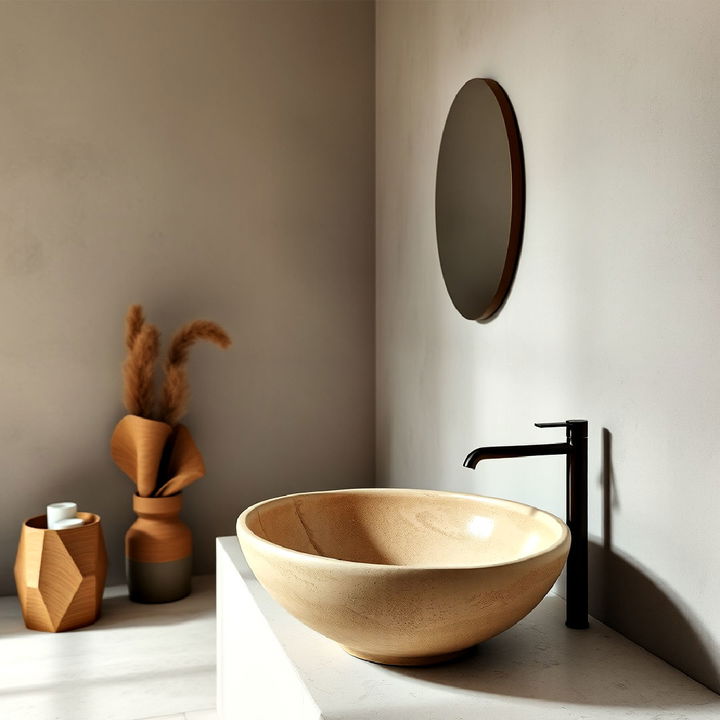
Wabi-sabi, the Japanese aesthetic of finding beauty in imperfection, can be subtly incorporated into a Japandi bathroom. This might take the form of uneven, handmade ceramics or a slightly irregular stone basin. These imperfections introduce a touch of humanity and authenticity, reminding us that beauty lies in the unique and natural. Embracing wabi-sabi allows for a more relaxed, lived-in feel without compromising the minimalist, serene atmosphere.
33. Clean, Straight-Edged Cabinetry
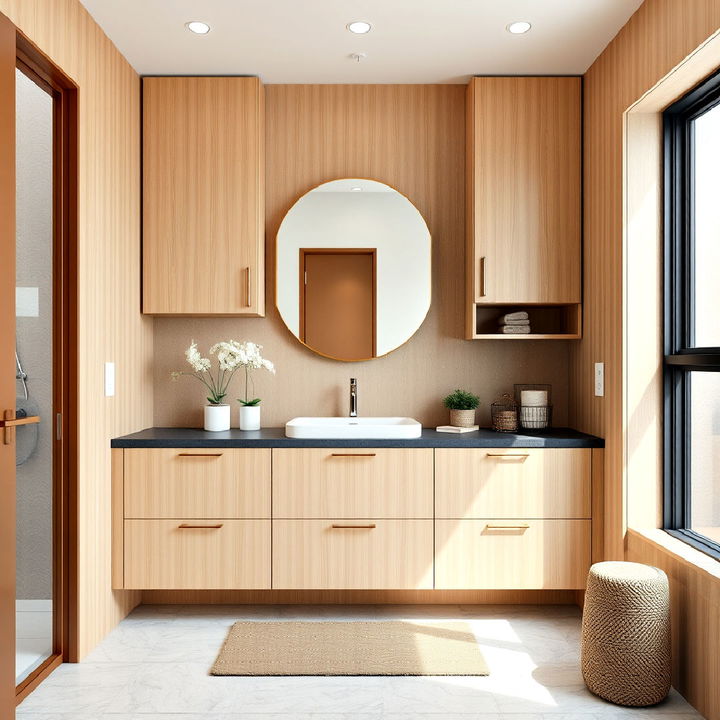
Straight-edged cabinetry is a hallmark of minimalist design, and it fits perfectly into a Japandi bathroom. Clean, sharp lines on vanities and storage cabinets keep the space feeling organized and streamlined. Opt for light woods or neutral-colored finishes that blend with the overall theme. The cabinetry should prioritize functionality, with hidden storage that minimizes clutter, reflecting the Japanese principle of efficiency and the Scandinavian love for simplicity.
34. Frosted Glass Windows for Privacy
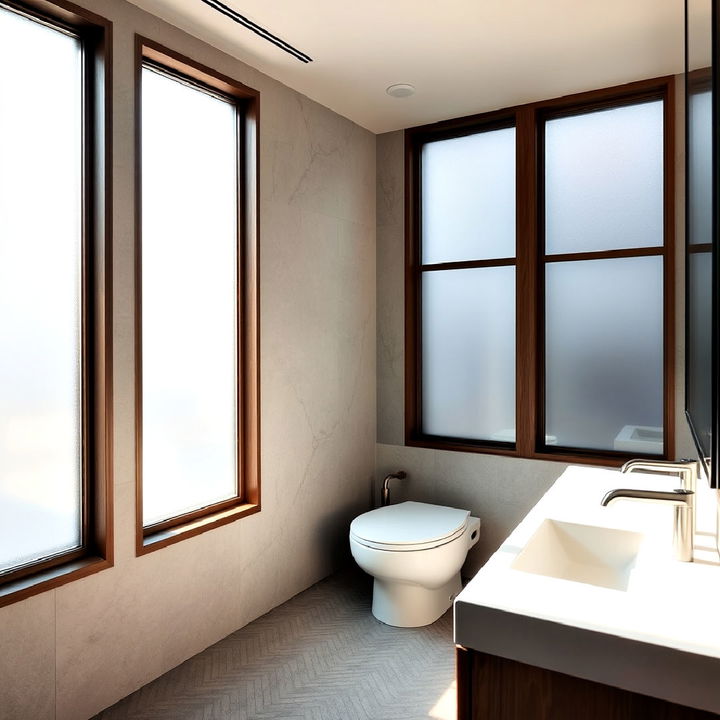
Frosted glass windows offer a perfect solution for maintaining privacy in your Japandi bathroom without sacrificing natural light. The soft diffusion of light through frosted glass creates a tranquil, ethereal effect, while still allowing the room to feel bright and open. This choice reinforces the balance of form and function, giving you both privacy and a sense of openness in the bathroom space.
35. Matte Finish Tiles for a Subtle Touch
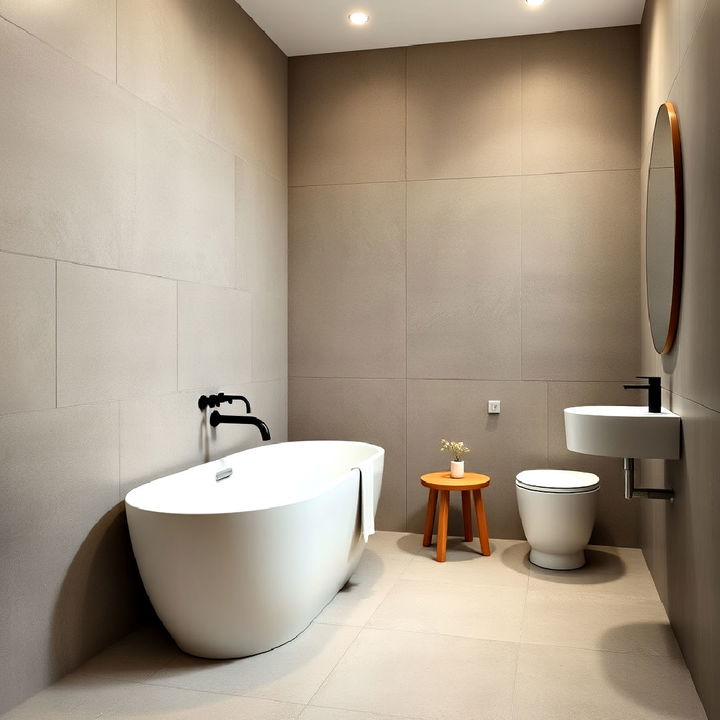
Matte finish tiles are ideal for a Japandi bathroom, as they provide a subtle, understated elegance. Unlike glossy tiles, matte finishes offer a softer, more natural feel that fits perfectly with the minimalist aesthetic. These tiles work well for both walls and floors, and their subdued texture prevents them from overpowering the space. The natural, muted look also makes the room feel warmer and more inviting, contributing to the overall calm atmosphere.
36. Compact Storage Solutions
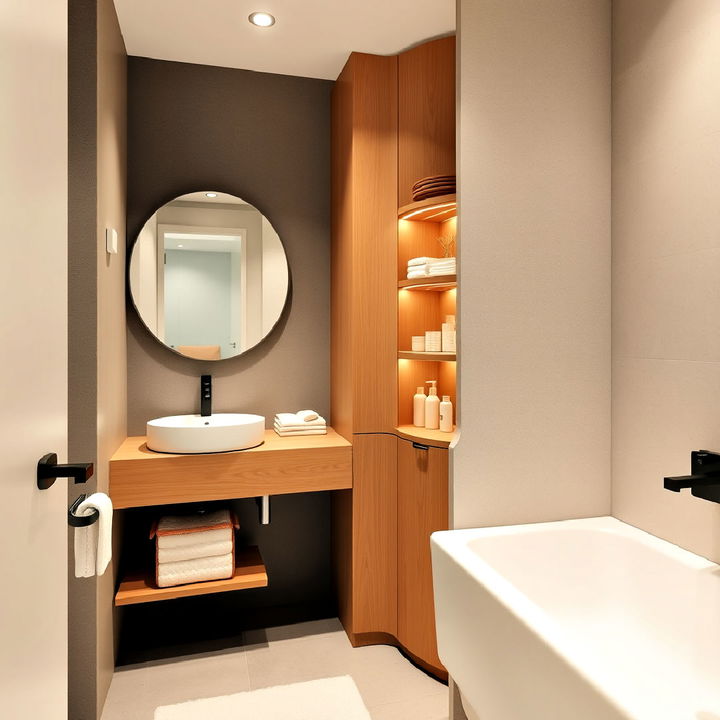
Create a serene space with Japandi small bathroom design, blending functionality with minimalist, natural beauty. Compact, hidden storage solutions keep a Japandi bathroom free of clutter while maximizing functionality. Opt for recessed shelves, built-in cabinets, or under-sink storage that maintains the clean, minimalist lines of the space. By keeping toiletries and other items neatly tucked away, you enhance the room’s simplicity and ensure that only the most essential elements are on display. This approach aligns with the Japandi philosophy of minimalism and purposeful design.
37. Soft, Earthy Rug for Warmth
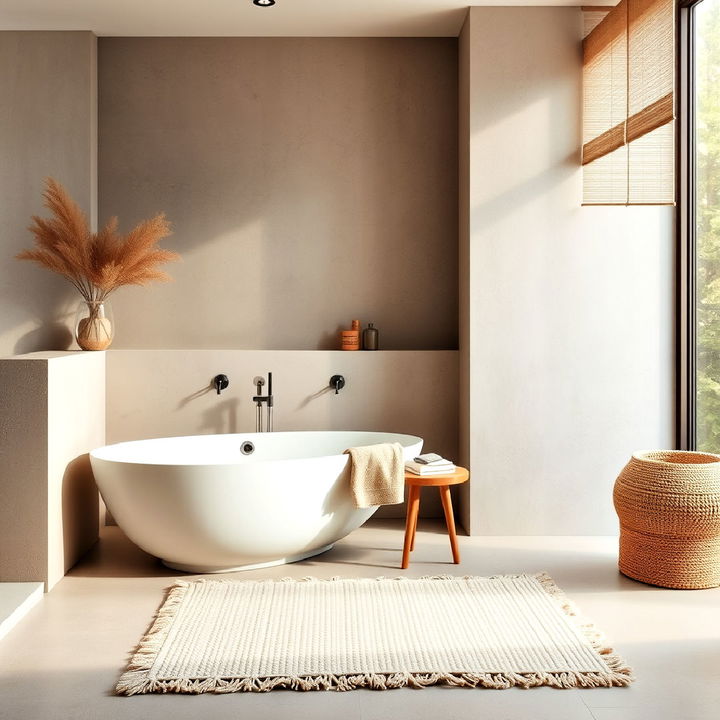
A soft, earthy-toned rug placed outside the bath or shower brings warmth and comfort to the bathroom without overpowering the minimalist design. Opt for natural fibers such as wool or cotton in neutral colors like beige, soft grey, or muted browns. This simple addition adds texture underfoot and complements the natural materials often found in Japandi bathrooms, helping to create a warm, inviting atmosphere.
38. Black and White Contrast
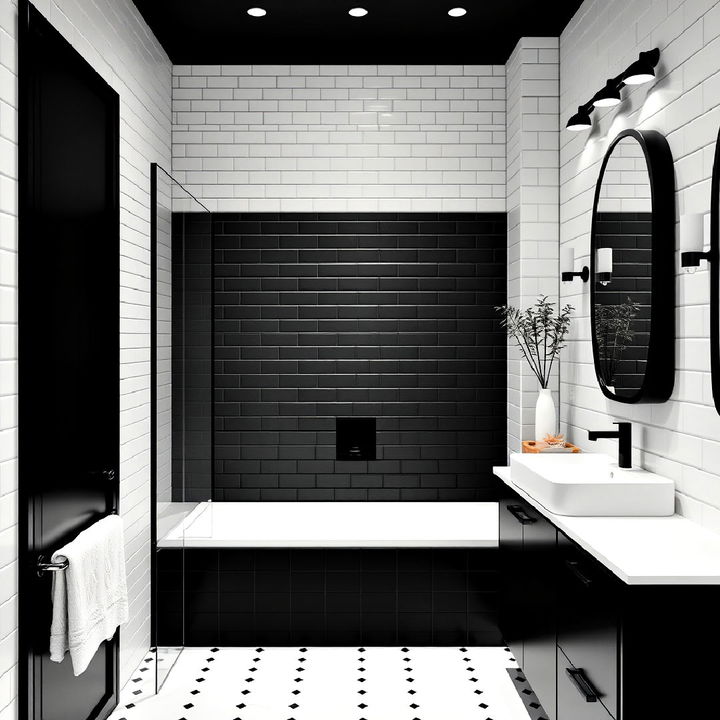
Incorporating a black and white color scheme into your Japandi bathroom introduces a sleek, modern edge while maintaining simplicity. Black fixtures or cabinetry paired with white walls or tiles create a clean, striking contrast. This minimalist color palette adds depth and sophistication without overwhelming the senses, keeping the space feeling open and airy. The combination of black and white reflects both the Scandinavian and Japanese appreciation for clean, uncluttered design.
39. Underfloor Heating for Comfort
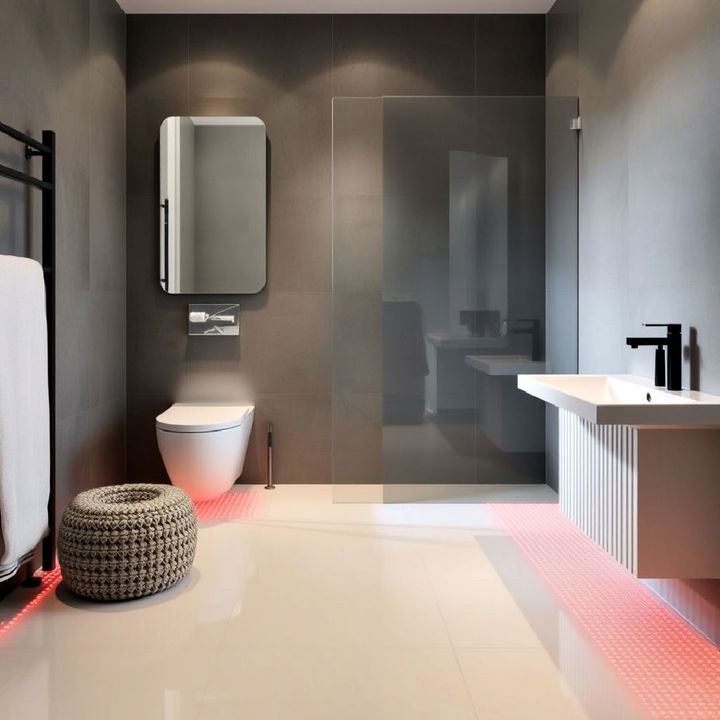
While it’s not a visual design element, underfloor heating can make a significant difference in the comfort of a Japandi bathroom. The luxurious warmth underfoot complements the minimalist aesthetic, providing comfort without the need for bulky radiators or visible heating systems. This hidden feature aligns with the Japandi focus on functionality, ensuring that every element of the bathroom serves a purpose without compromising its serene, uncluttered vibe.
40. Japanese-Inspired Soaking Tub
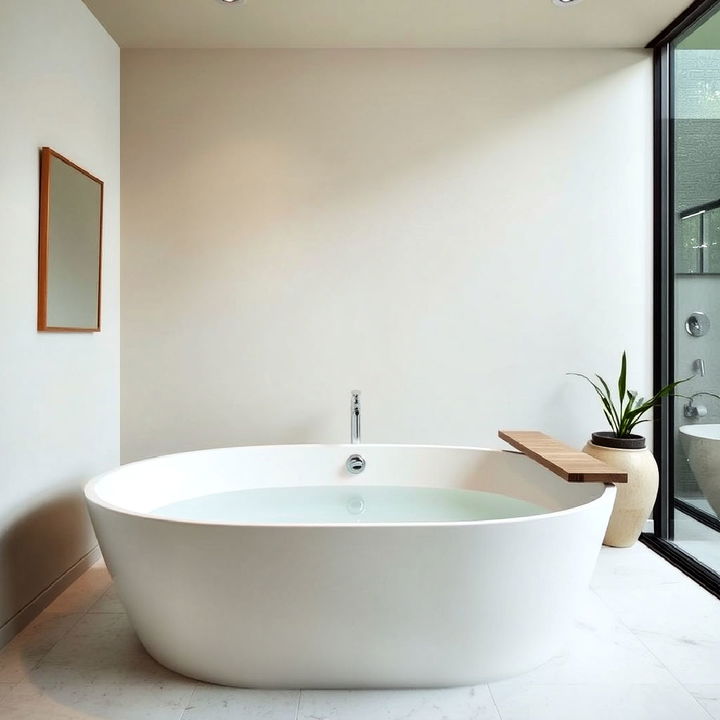
For the ultimate in relaxation, consider installing a Japanese-style soaking tub in your Japandi bathroom. These deep tubs are designed for full immersion and promote the Japanese ritual of mindful bathing. The compact size makes them ideal for smaller spaces, while their simplicity and natural materials fit perfectly into the minimalist aesthetic. A soaking tub becomes a focal point in the bathroom, encouraging relaxation and mindfulness in a space designed for tranquility.
Conclusion:
Incorporating Japandi bathroom ideas like freestanding bathtubs, wooden accents, and neutral tones will transform your space into a minimalist haven. By blending natural materials with clean lines and thoughtfully placed décor, you can achieve a harmonious balance of warmth and simplicity. From floating vanities to soft linen textures, these elements will bring a sense of calm and serenity to your bathroom, making it the ideal retreat. Embrace this minimalist approach, and your Japandi bathroom will not only be a stylish statement but also a soothing escape from the everyday hustle.
Key Takeaways:
- Neutral Color Palette: Japandi bathrooms use calm, neutral tones like soft whites, beiges, and warm grays to create a peaceful, minimalist space.
- Natural Materials: Wooden accents, stone elements, and organic textures add warmth and balance to the minimalist aesthetic.
- Clean, Simple Lines: Floating vanities, frameless glass shower enclosures, and minimalist cabinetry maintain a sleek, uncluttered look.
- Functional Design: Features like built-in niches, open shelving, and compact storage solutions emphasize practicality without sacrificing style.
- Soft Lighting: Recessed or diffused lighting and low-profile fixtures create a serene ambiance, complementing the minimalist design.
- Zen Elements: Adding indoor plants, pebble flooring, and Japanese-inspired soaking tubs infuses the space with a sense of tranquility and connection to nature.
What to Do Next:
- Assess your bathroom space and consider incorporating natural materials and neutral tones.
- Explore minimalist fixtures, like floating vanities or matte black hardware, to maintain a clean and simple aesthetic.
- Focus on balancing functionality with aesthetics, ensuring the space feels both serene and practical.
- Introduce zen-inspired touches, like indoor plants or a wooden bath tray, to elevate the calming atmosphere.

